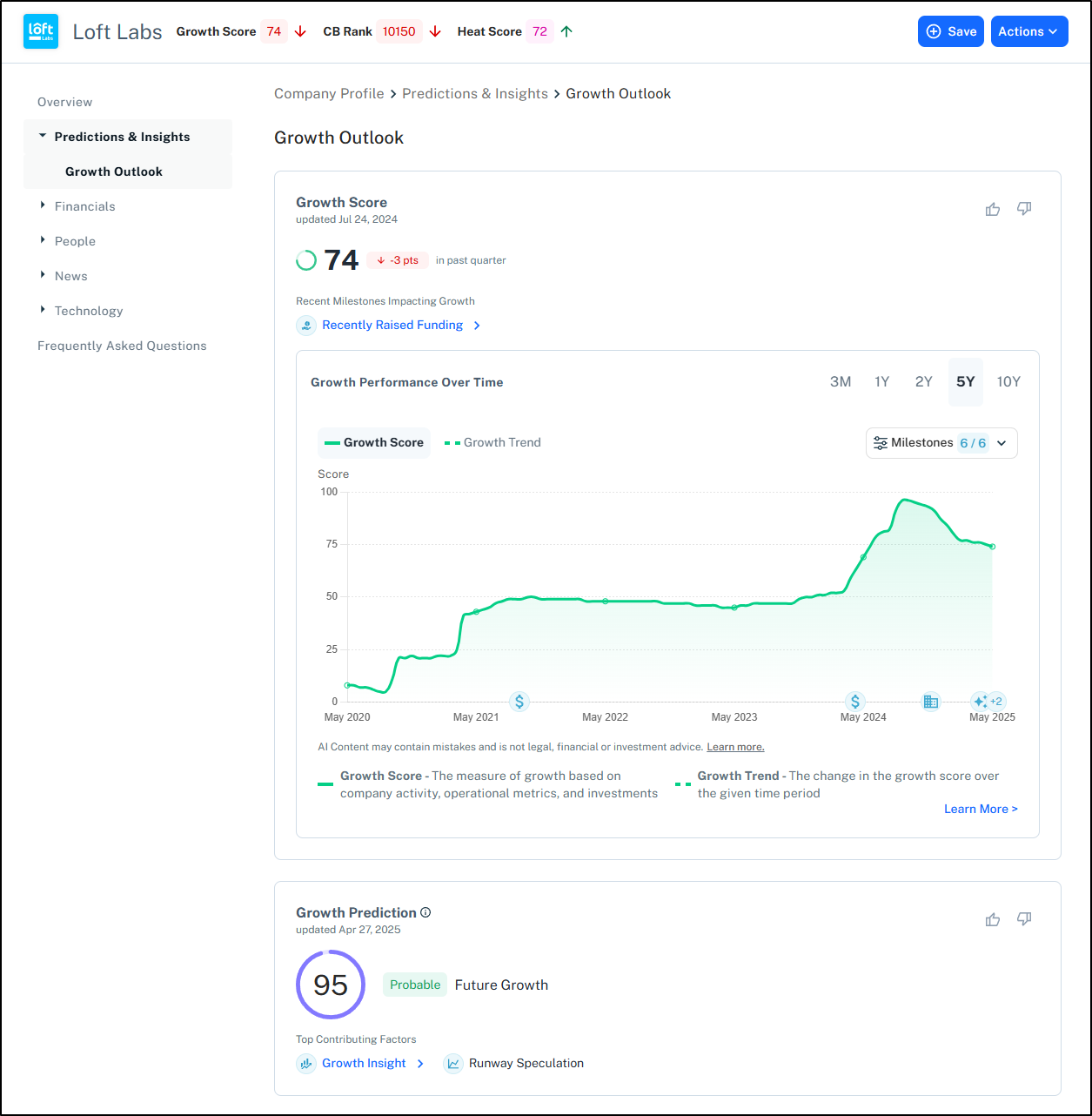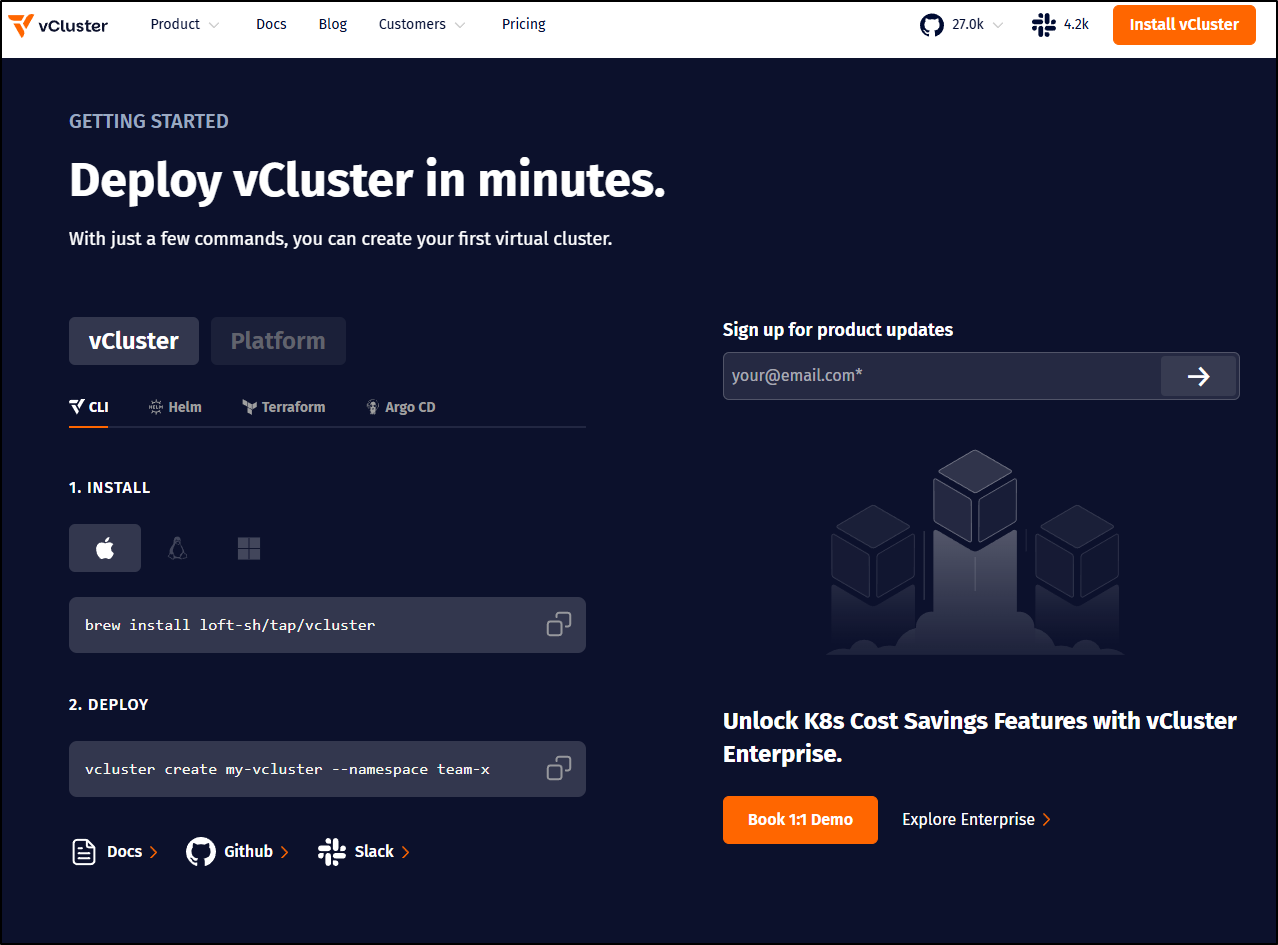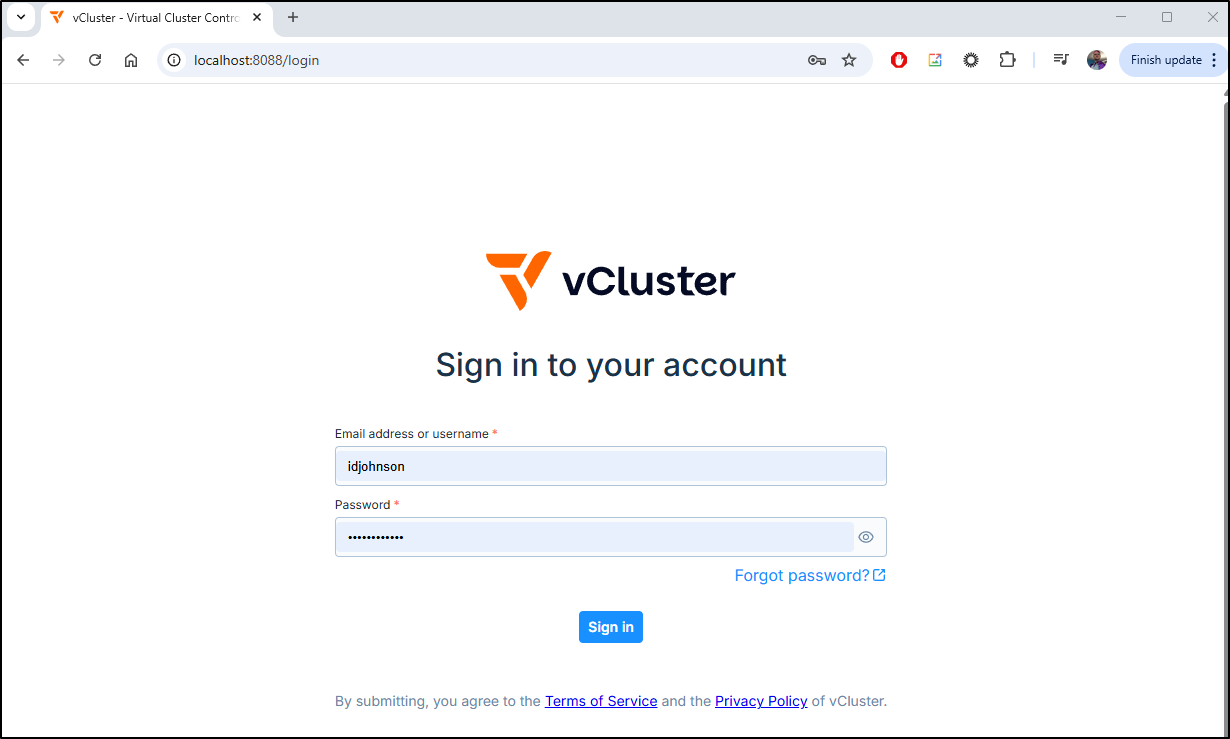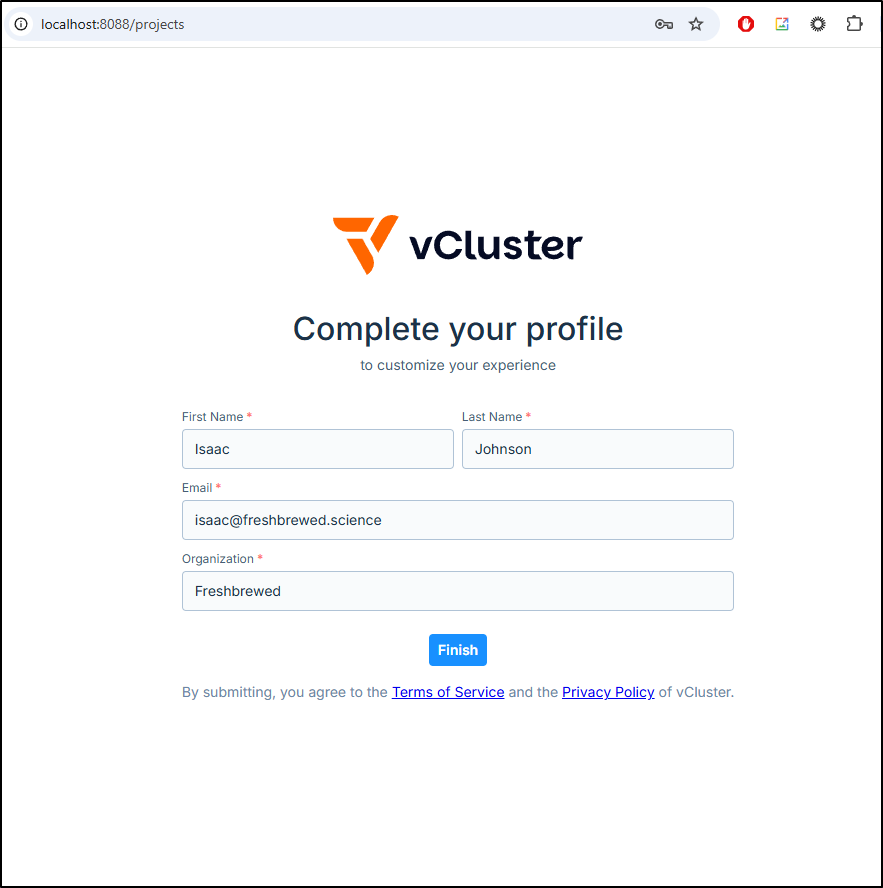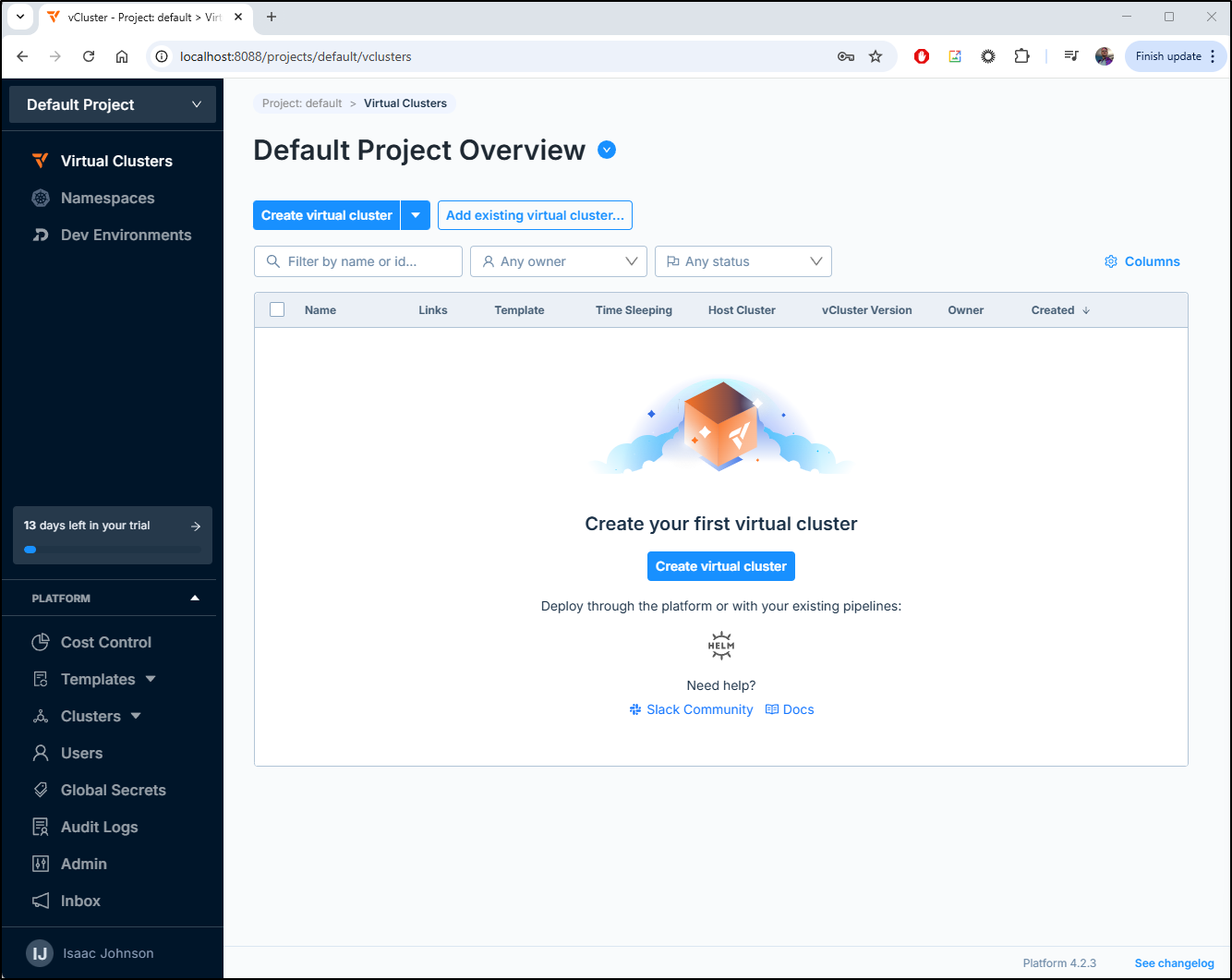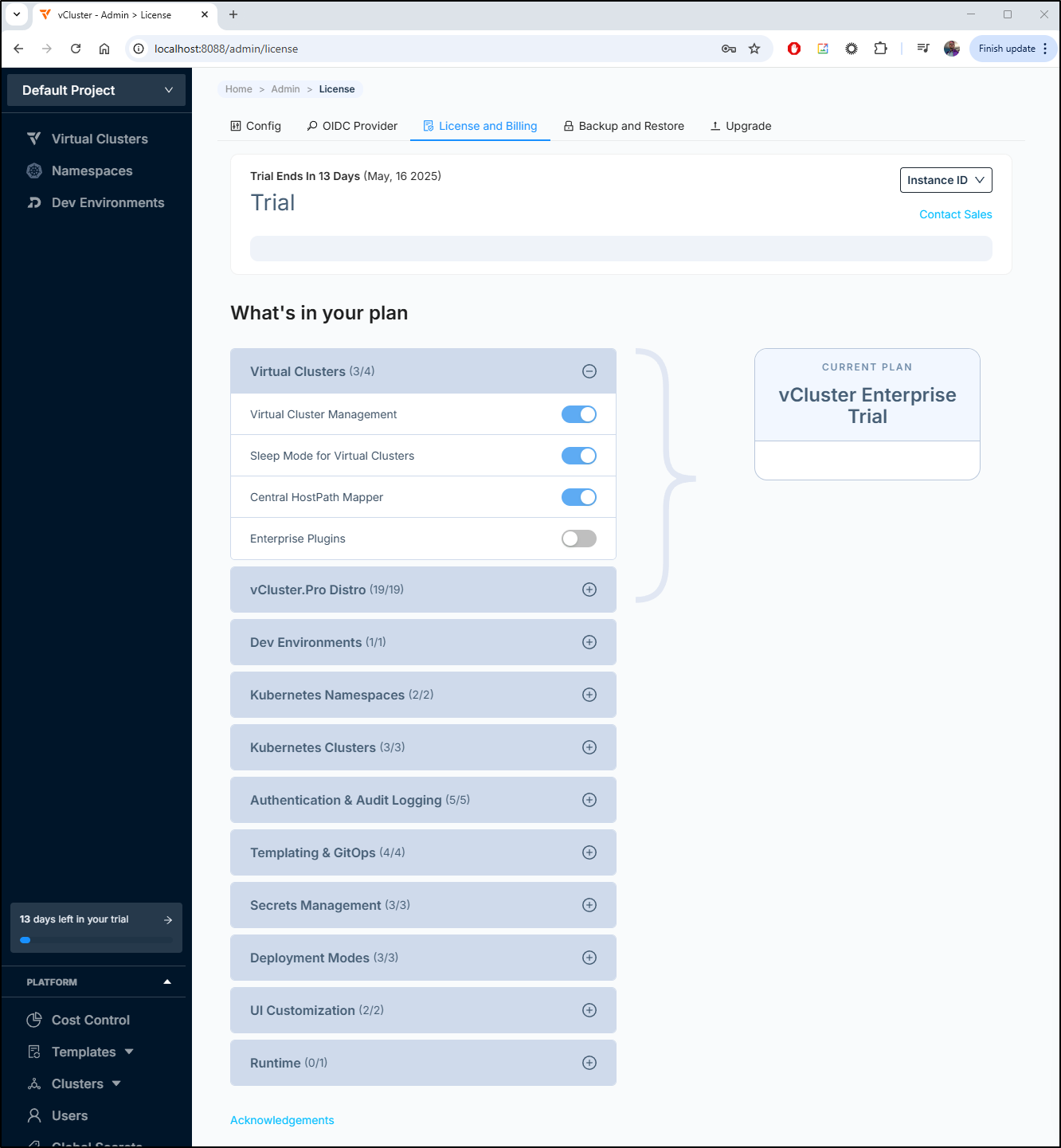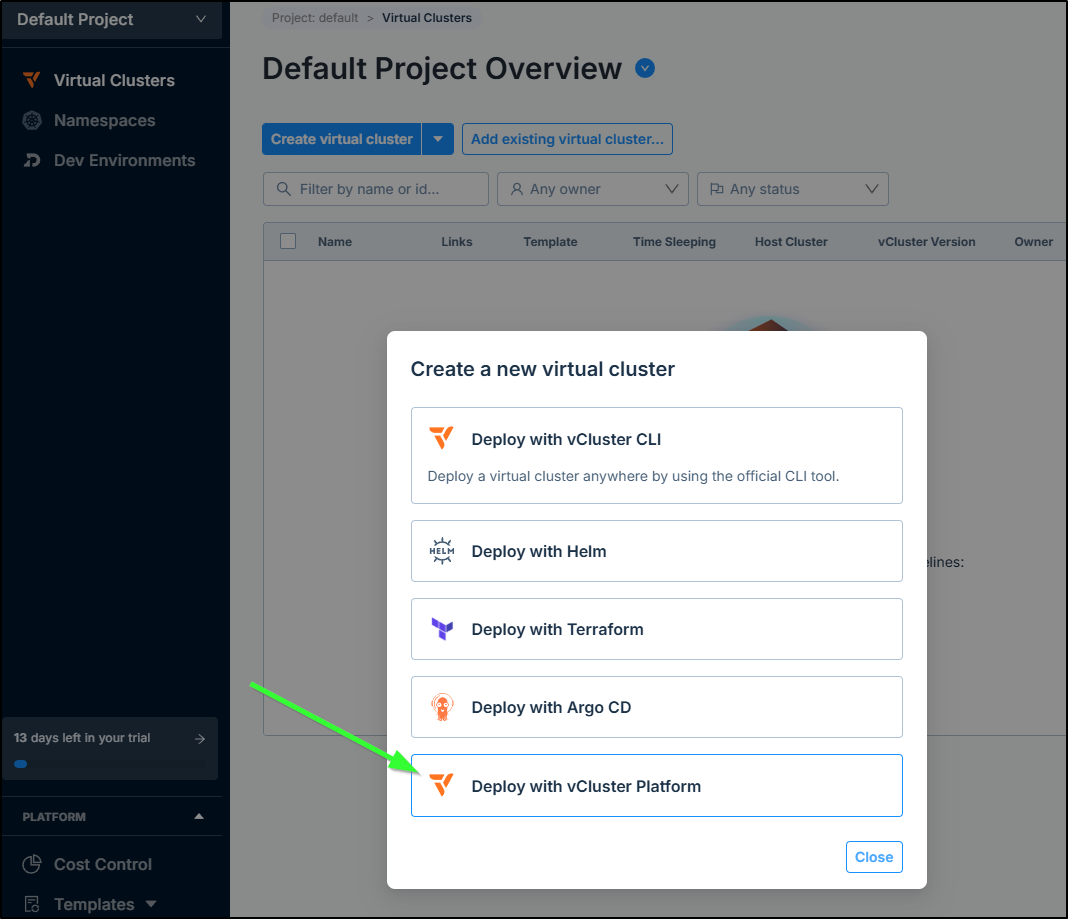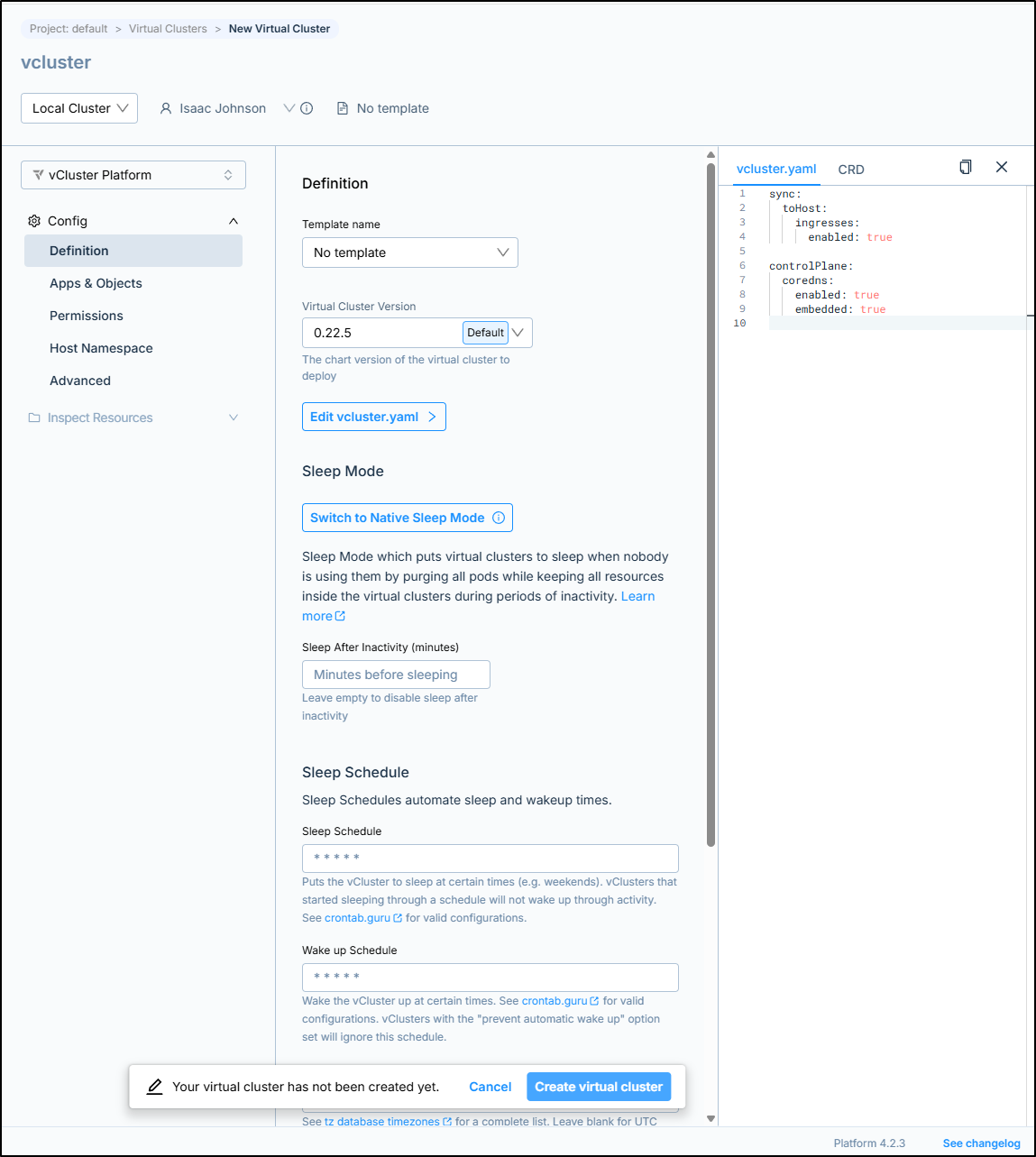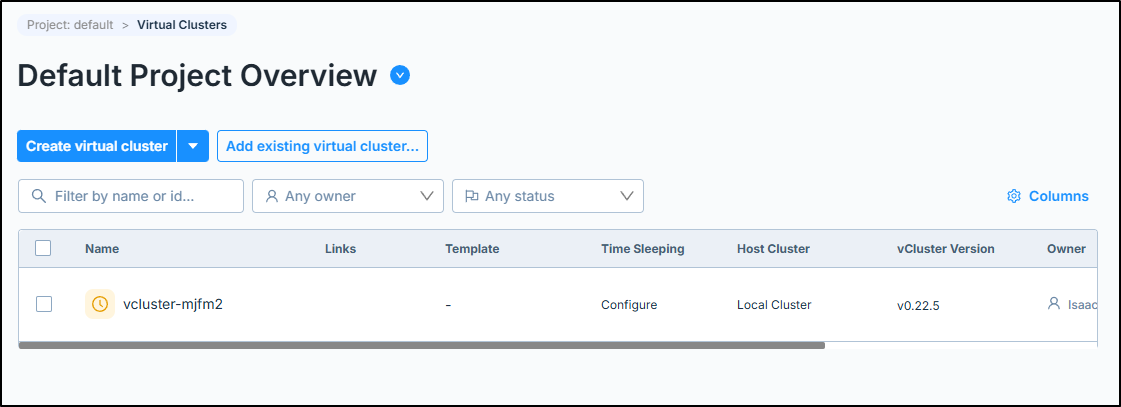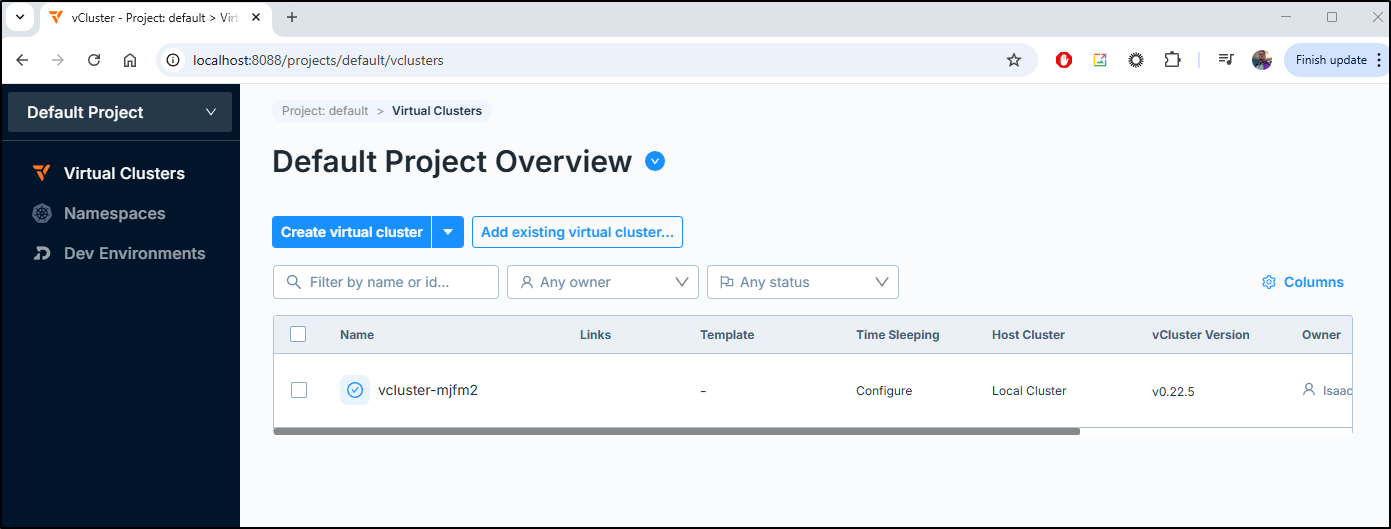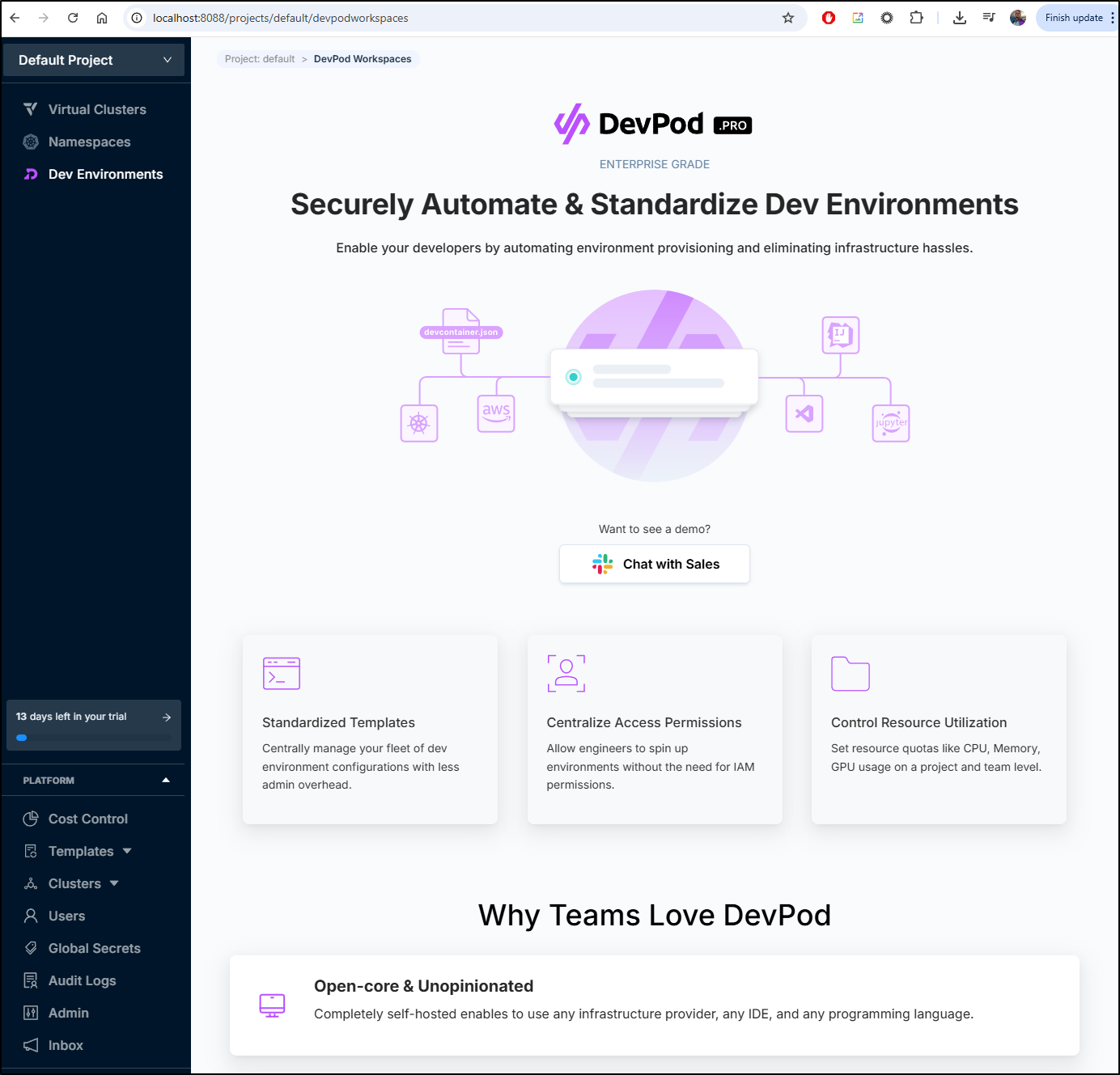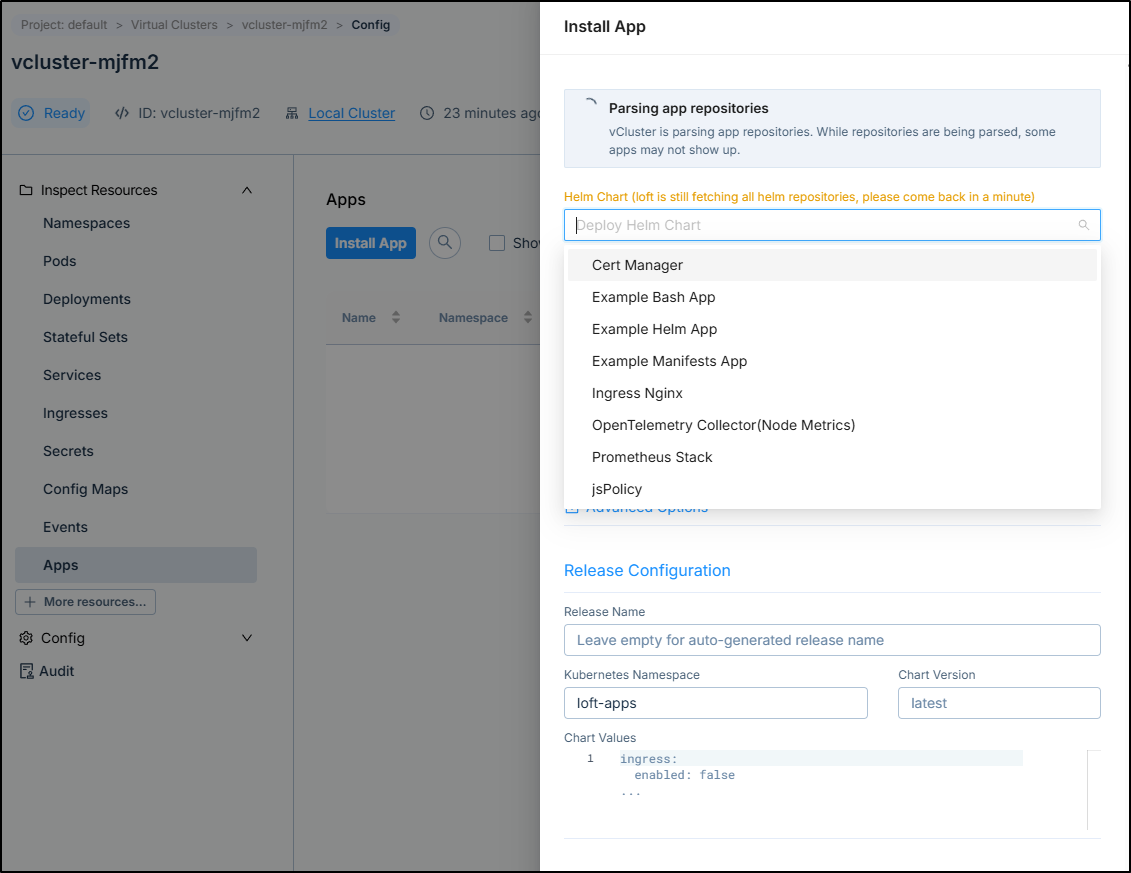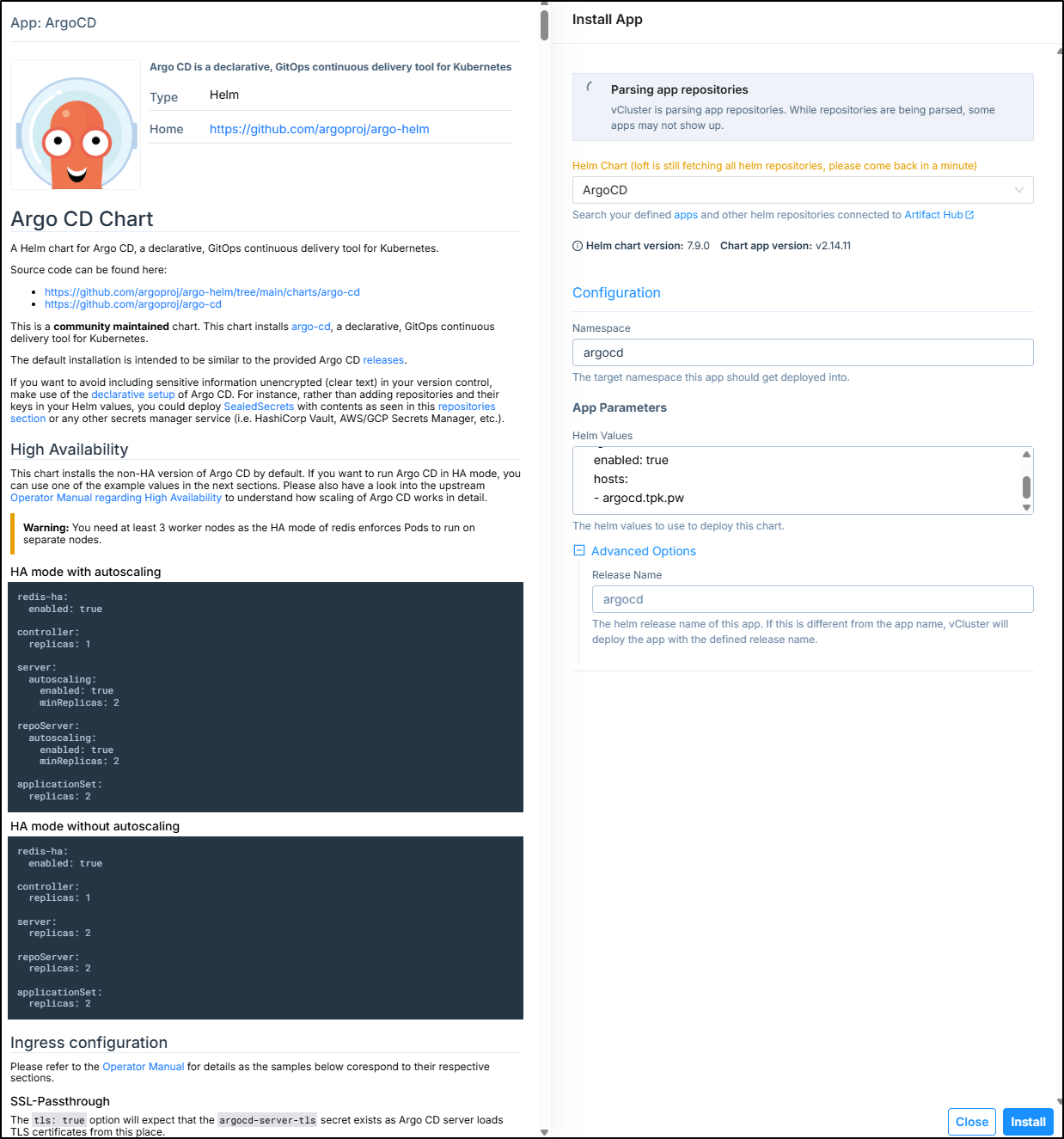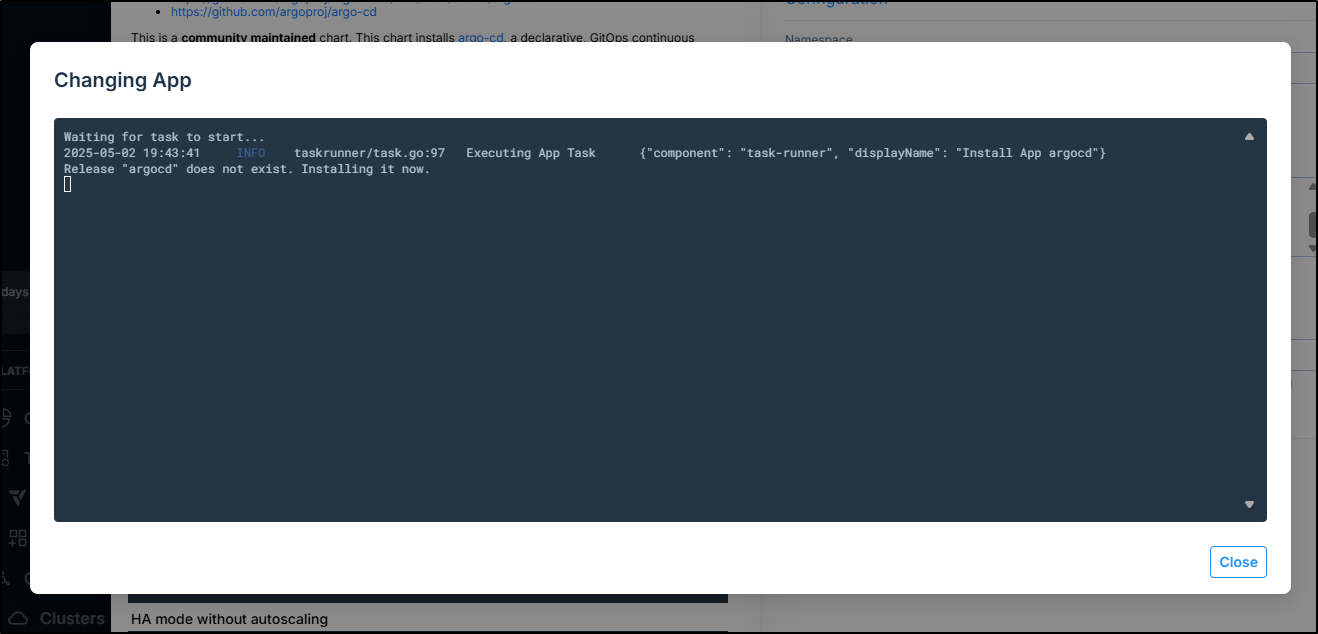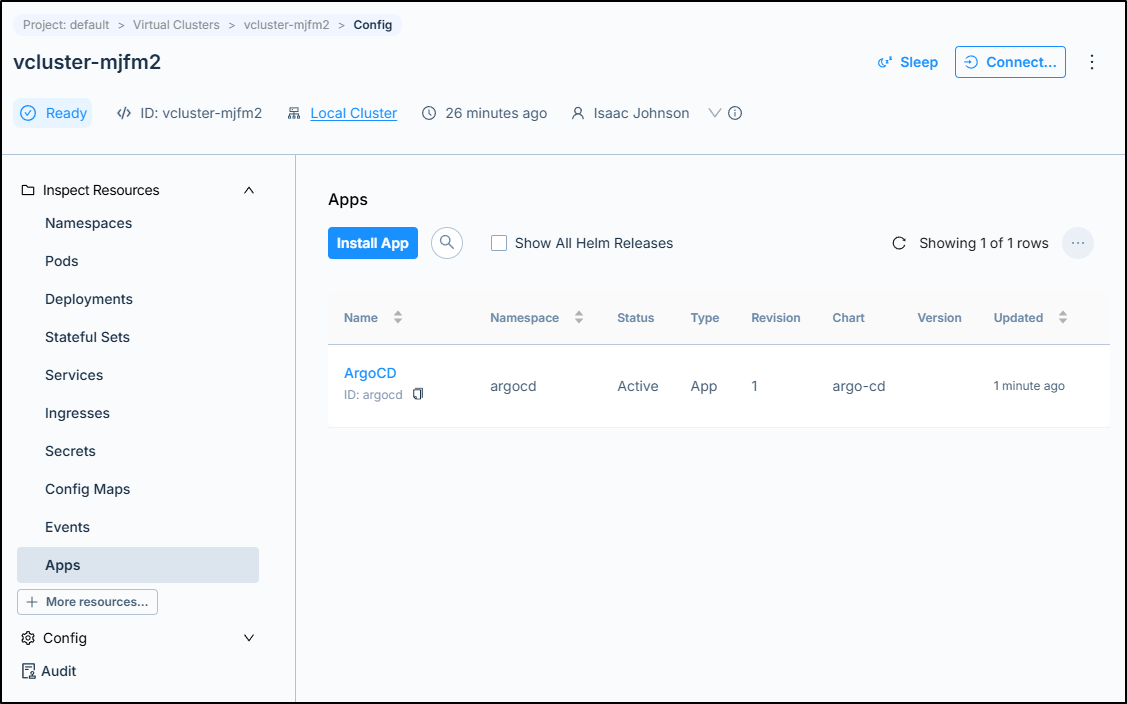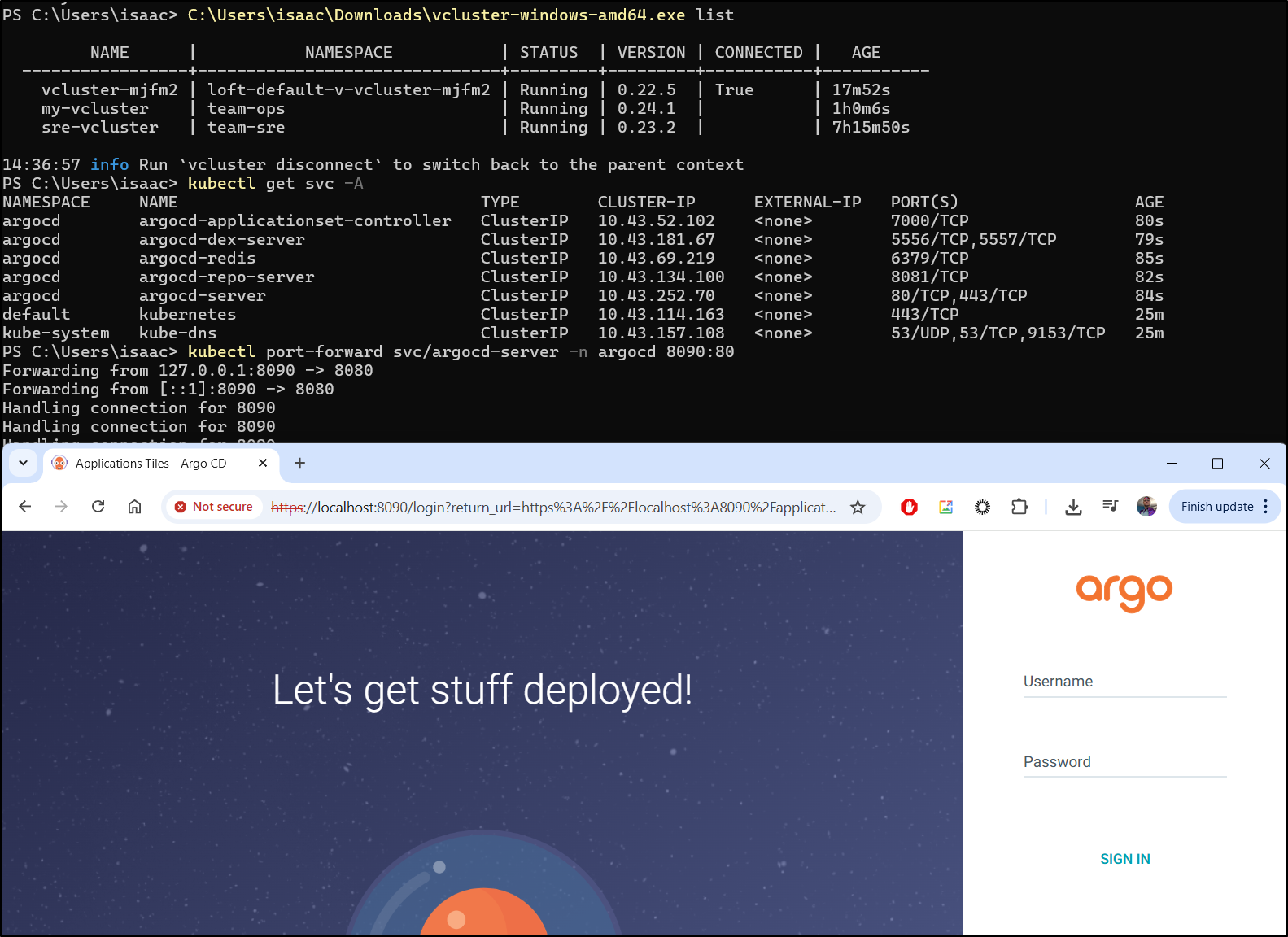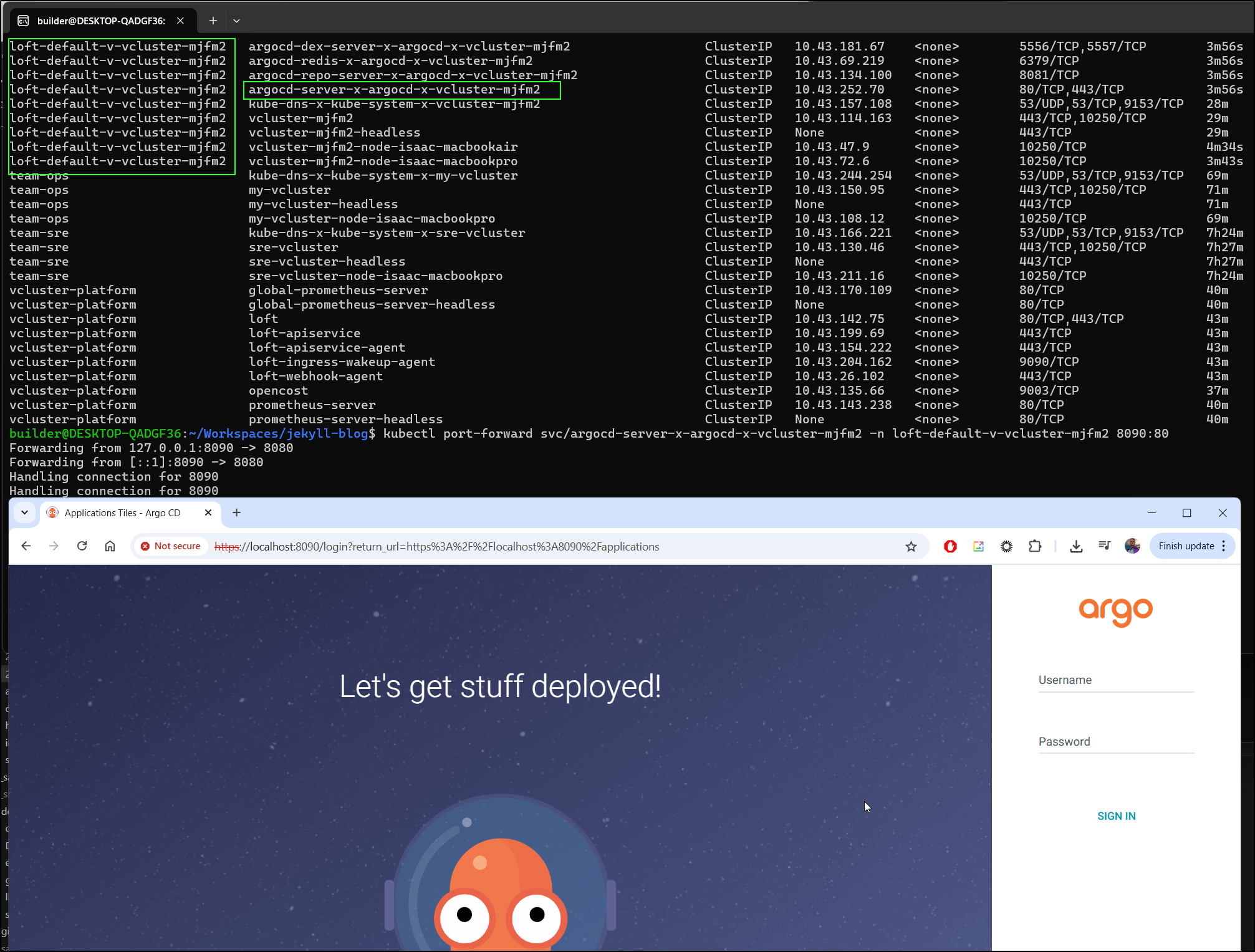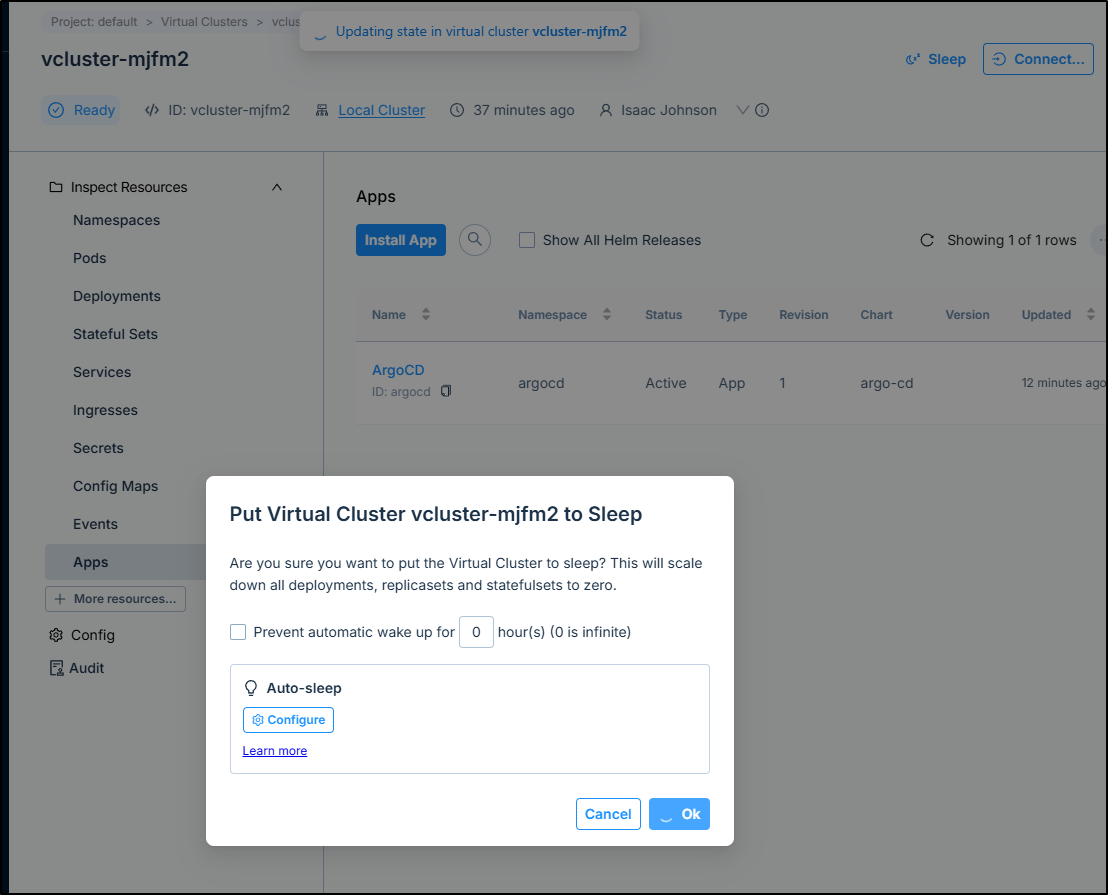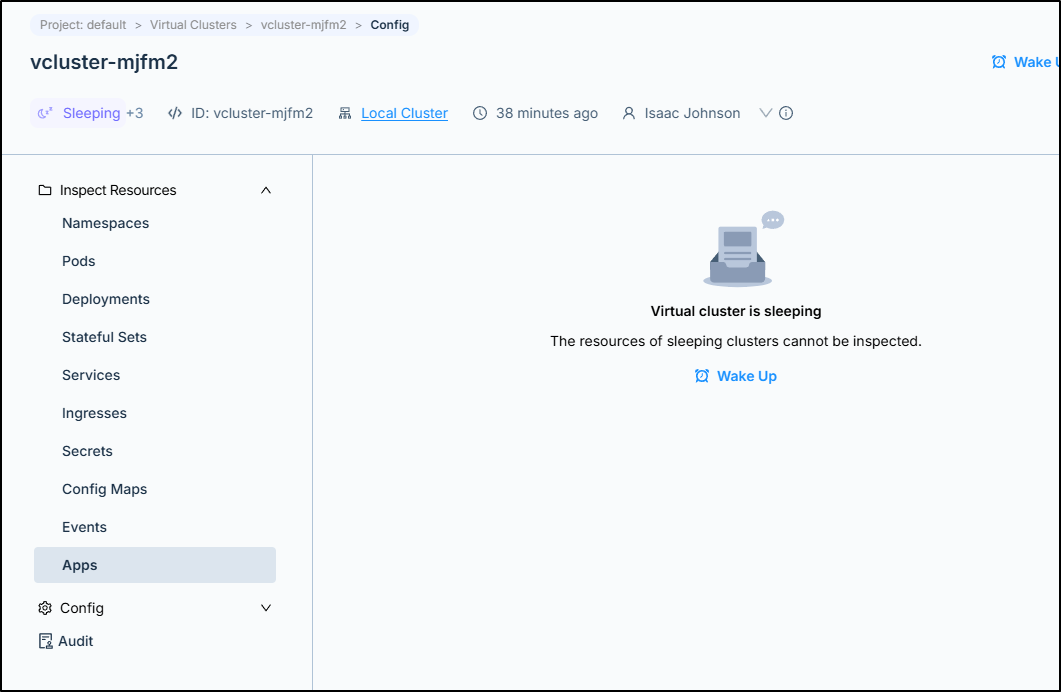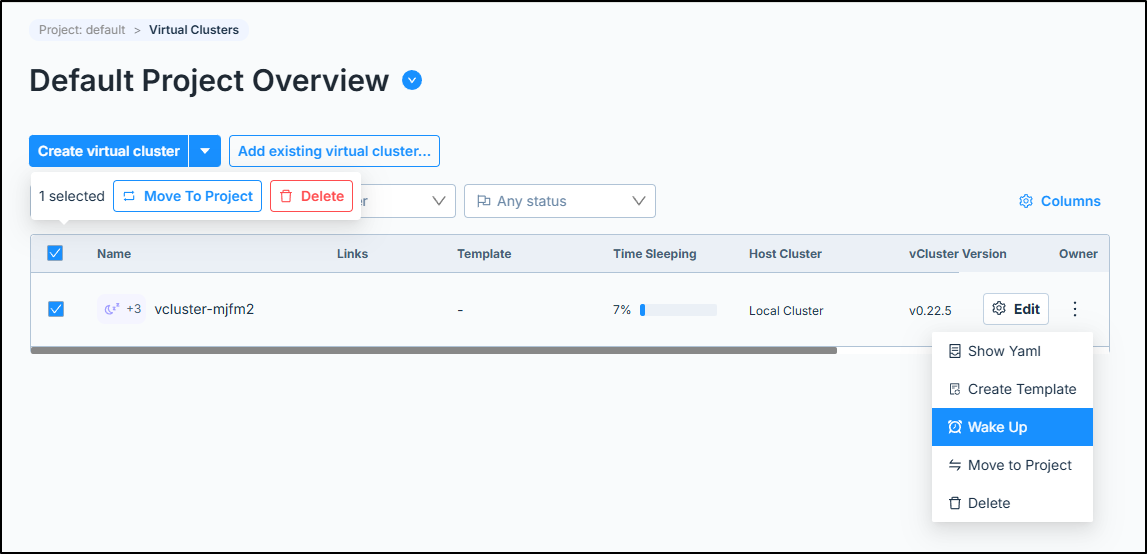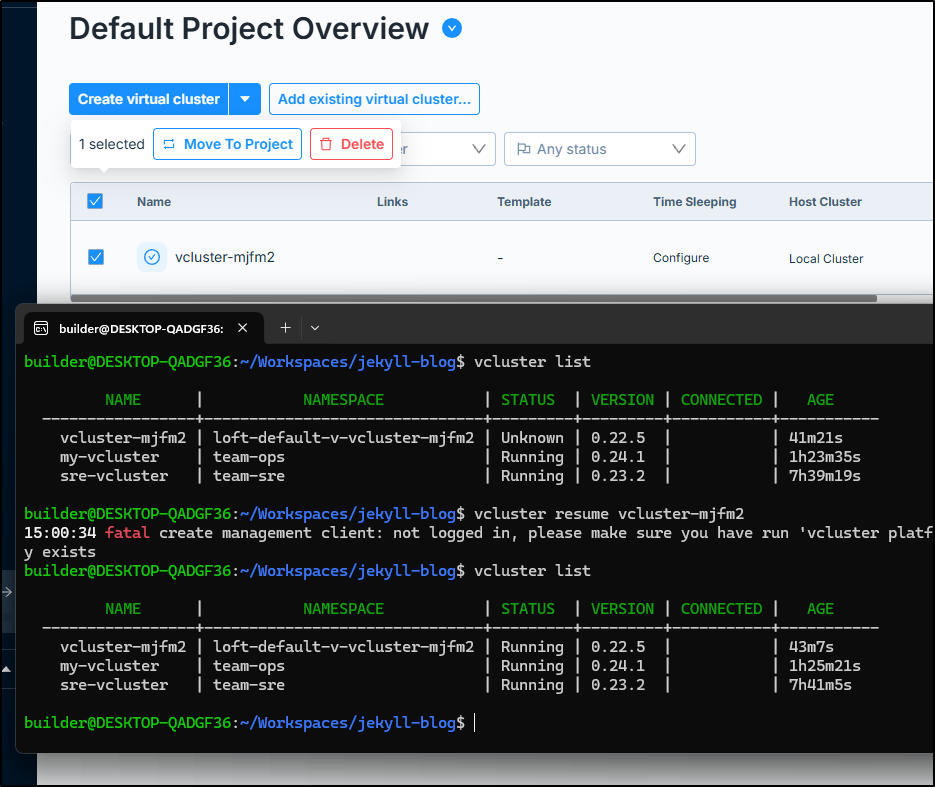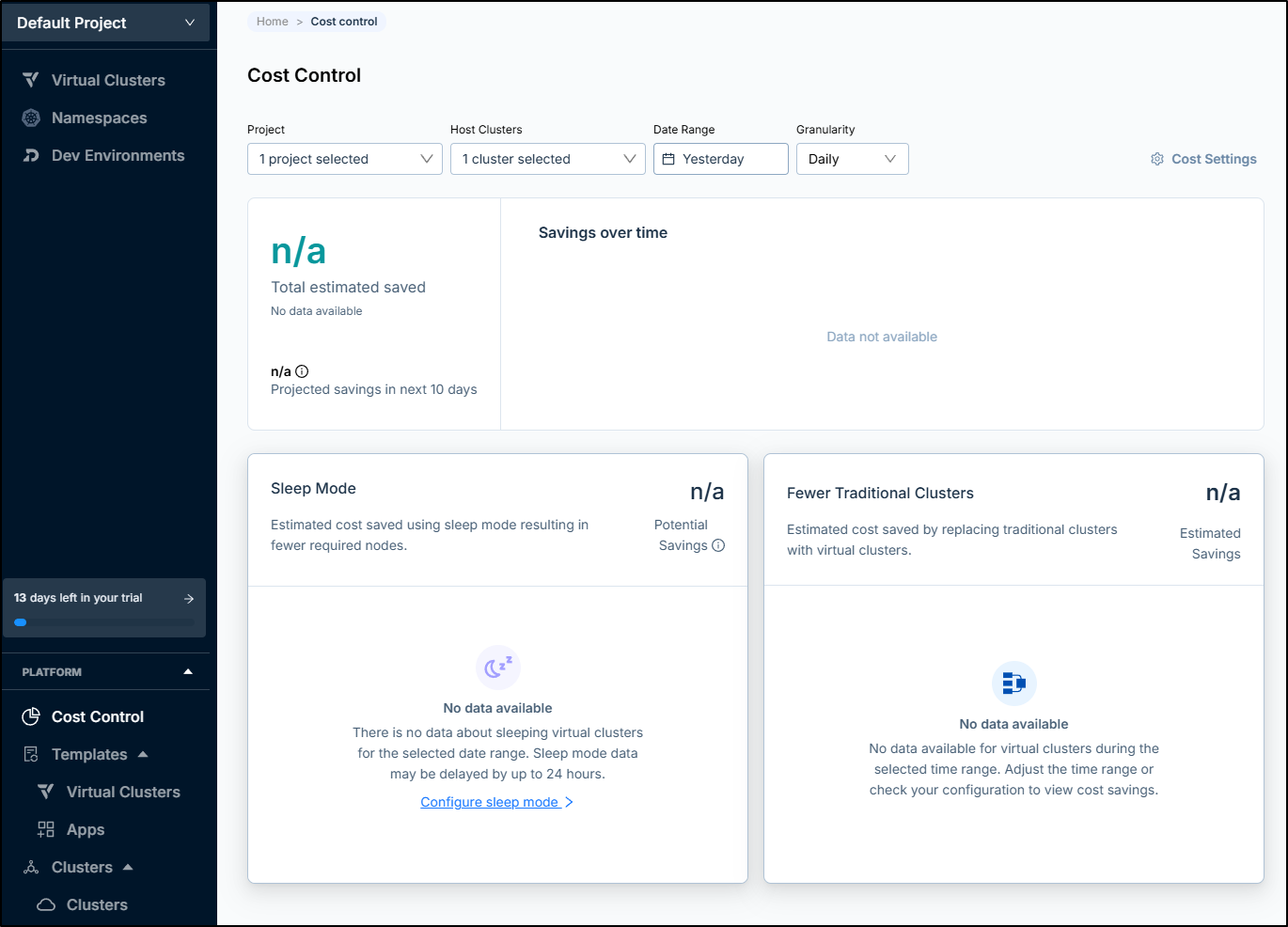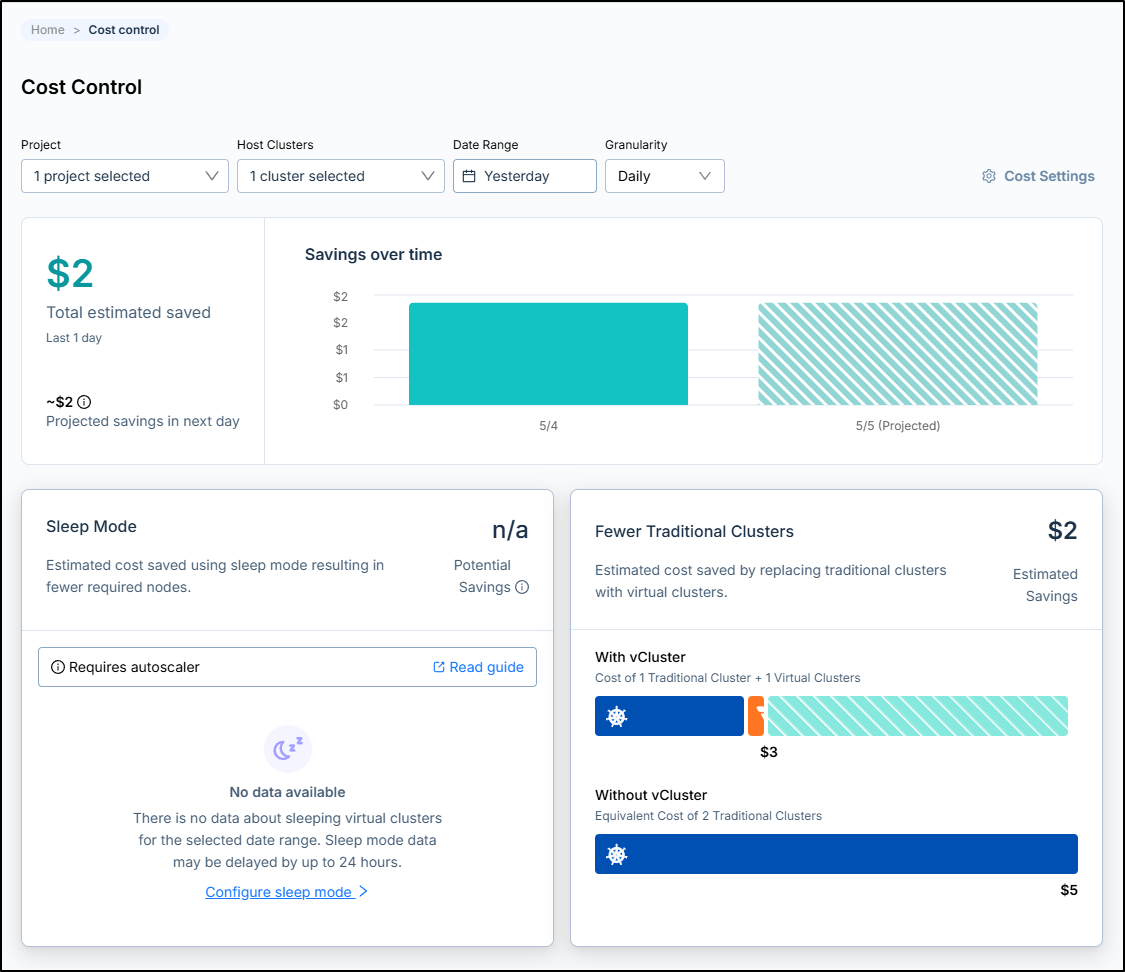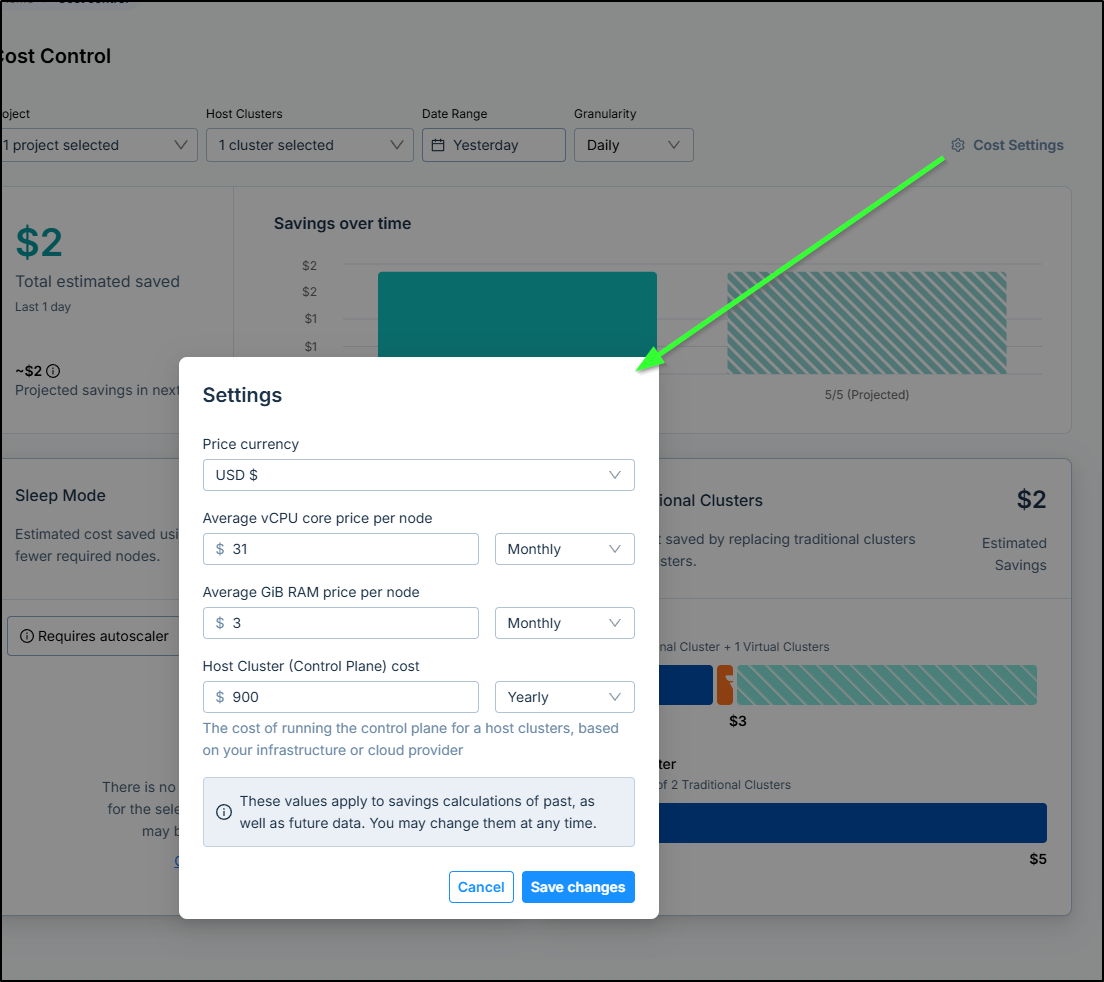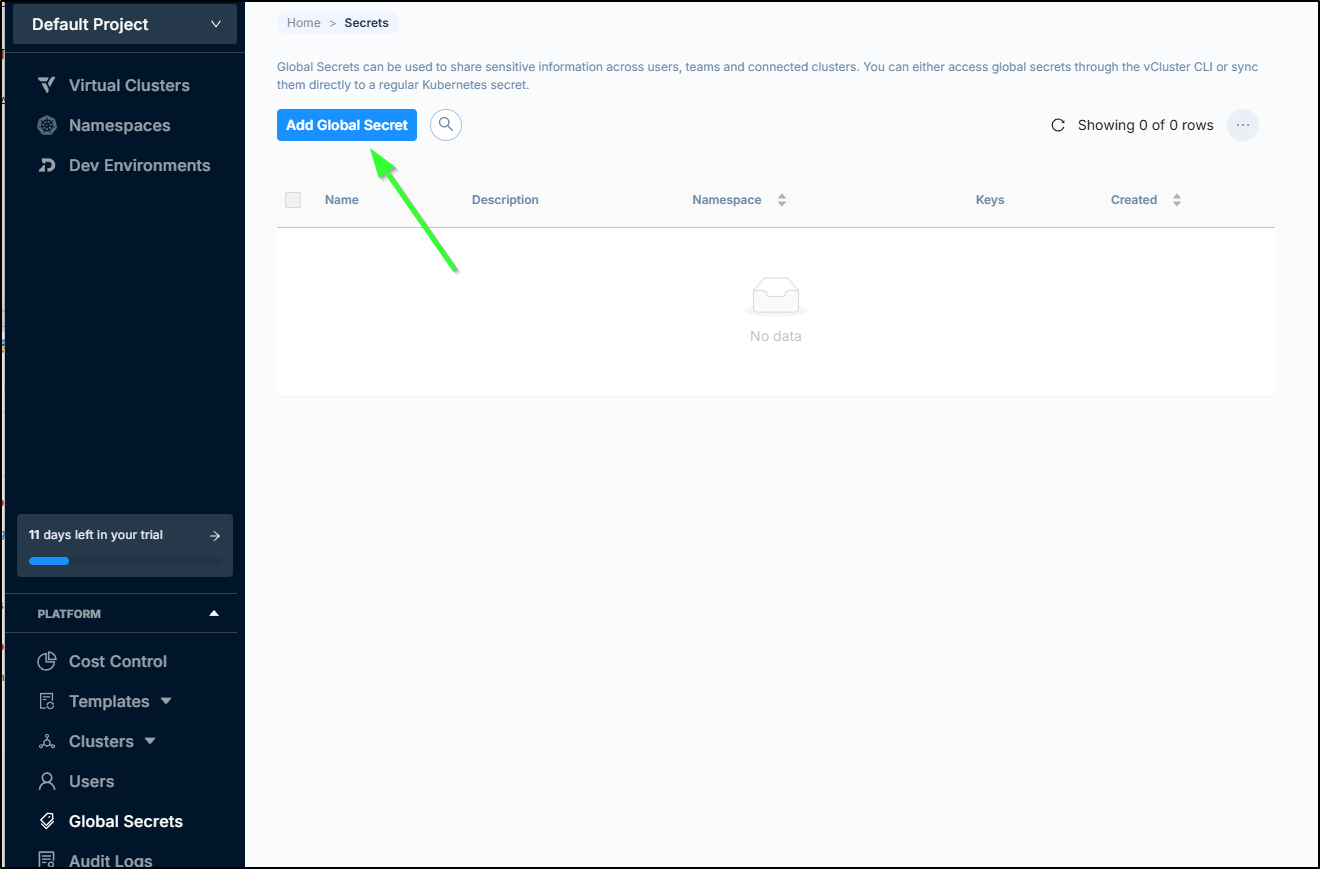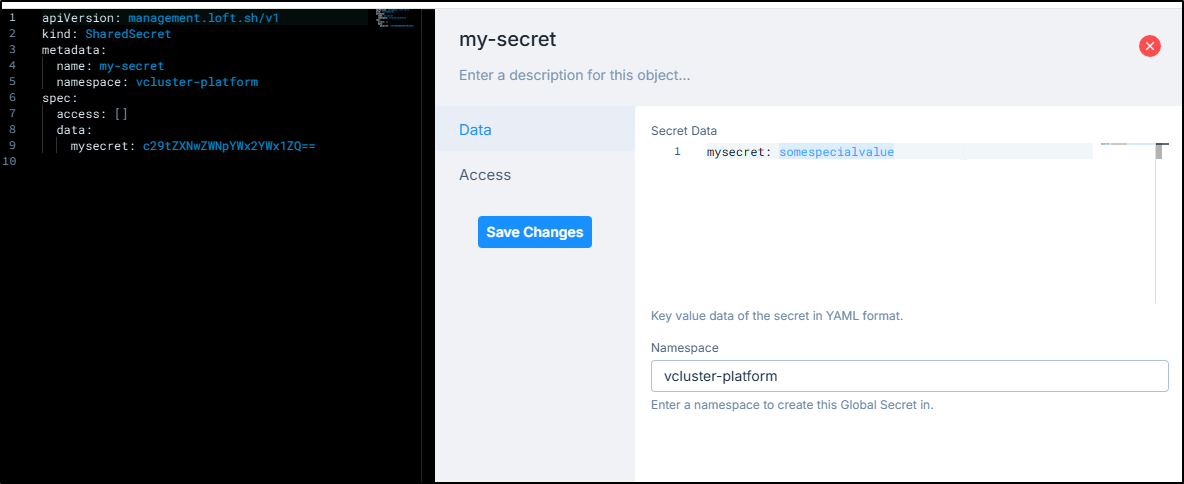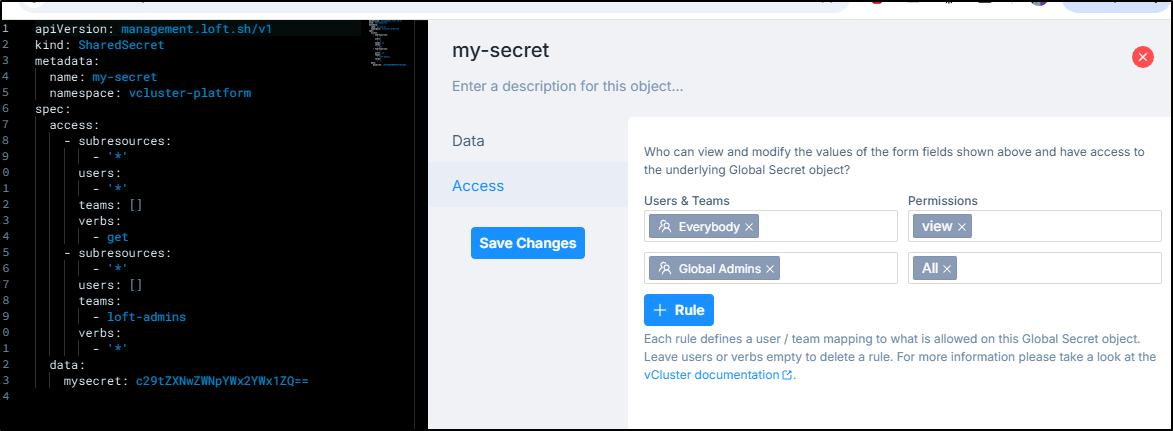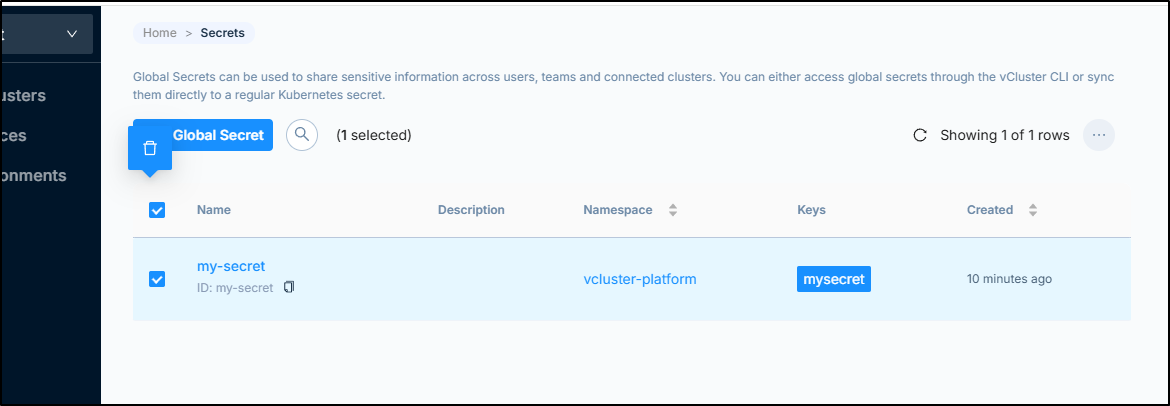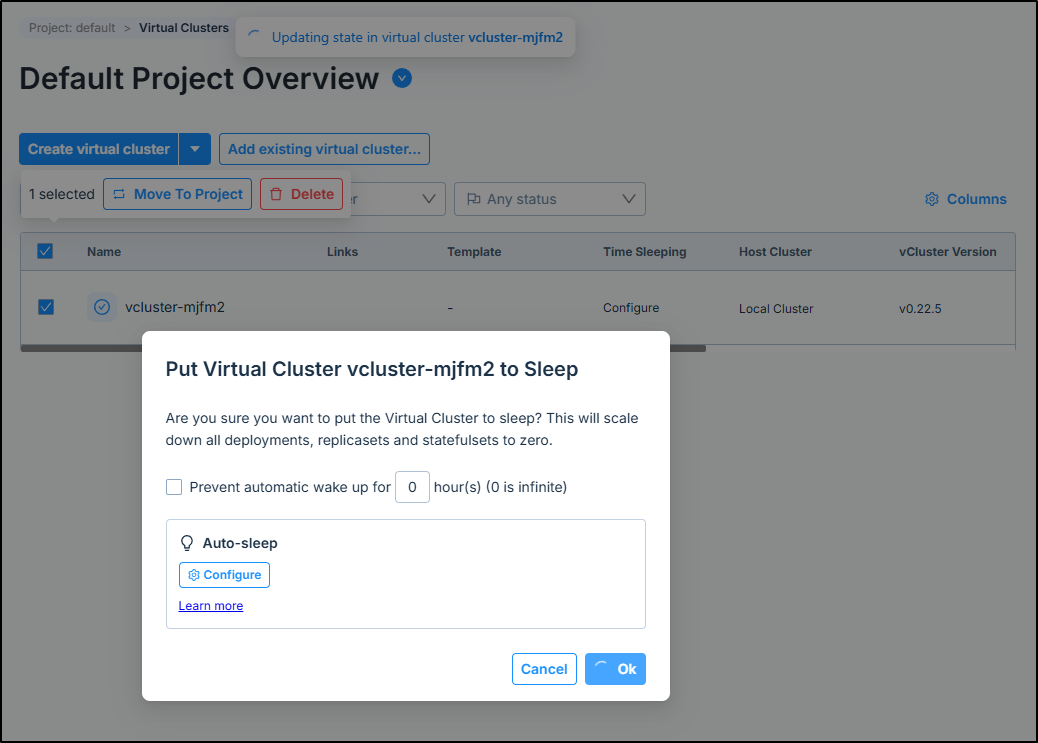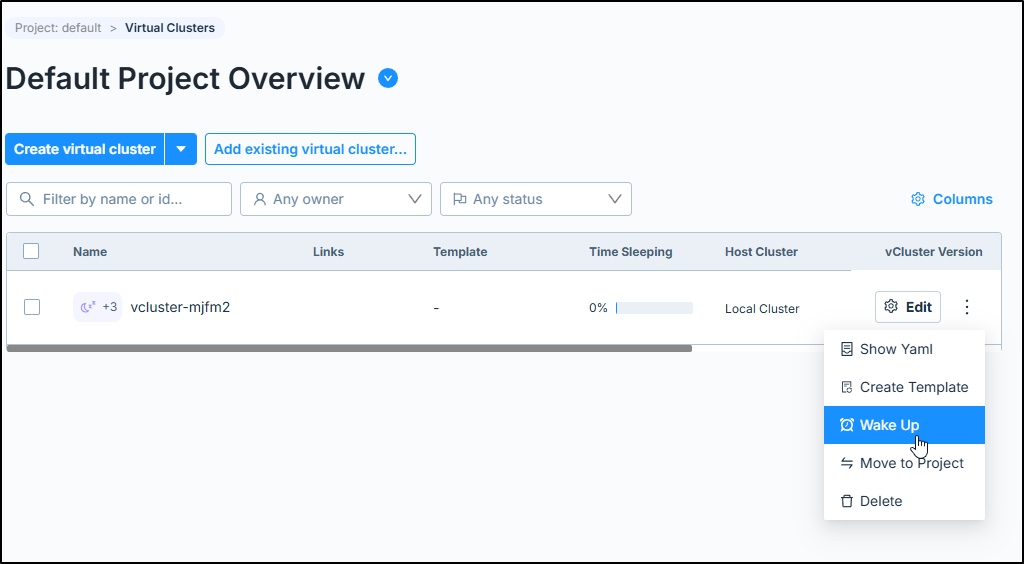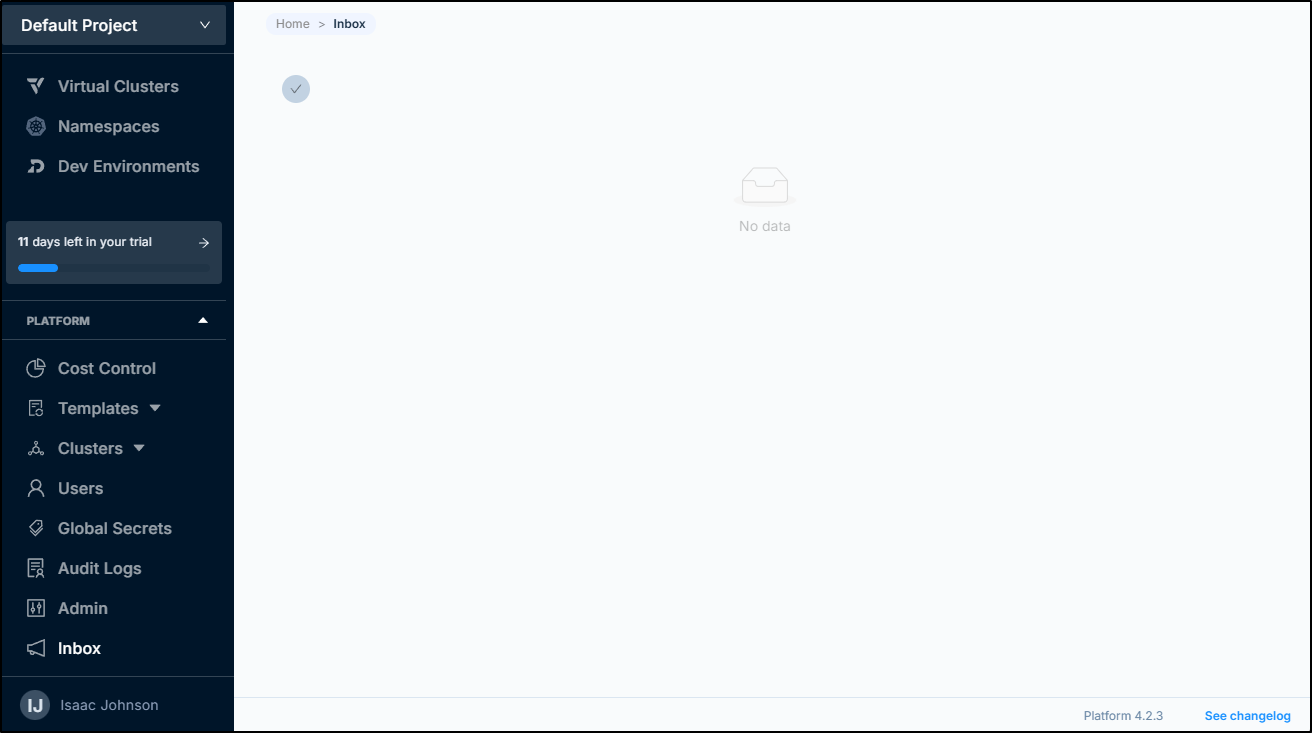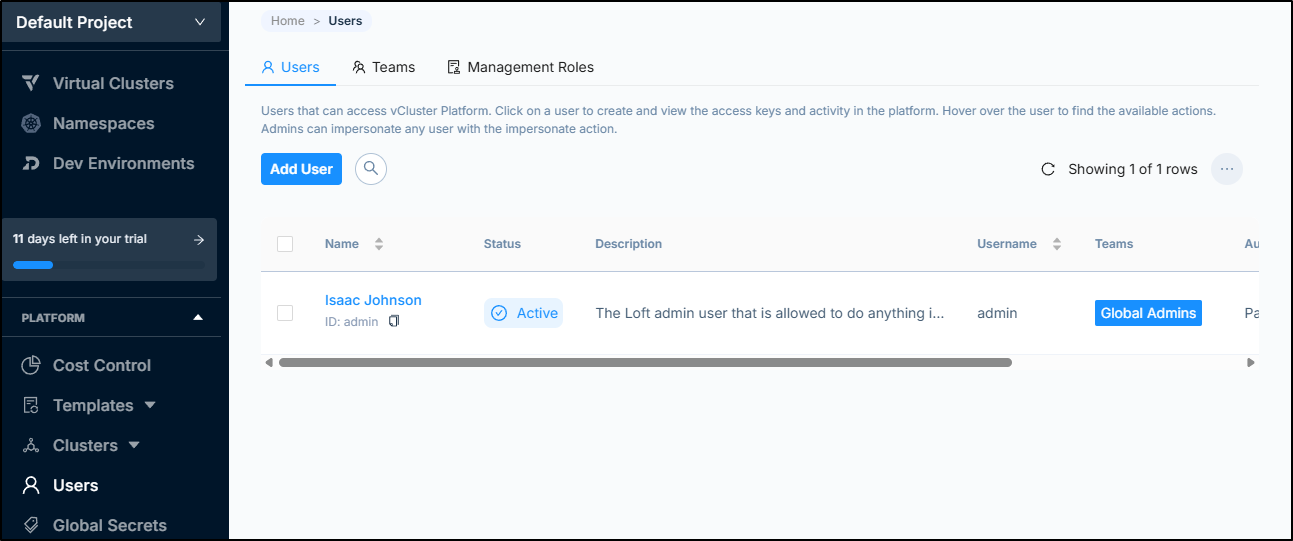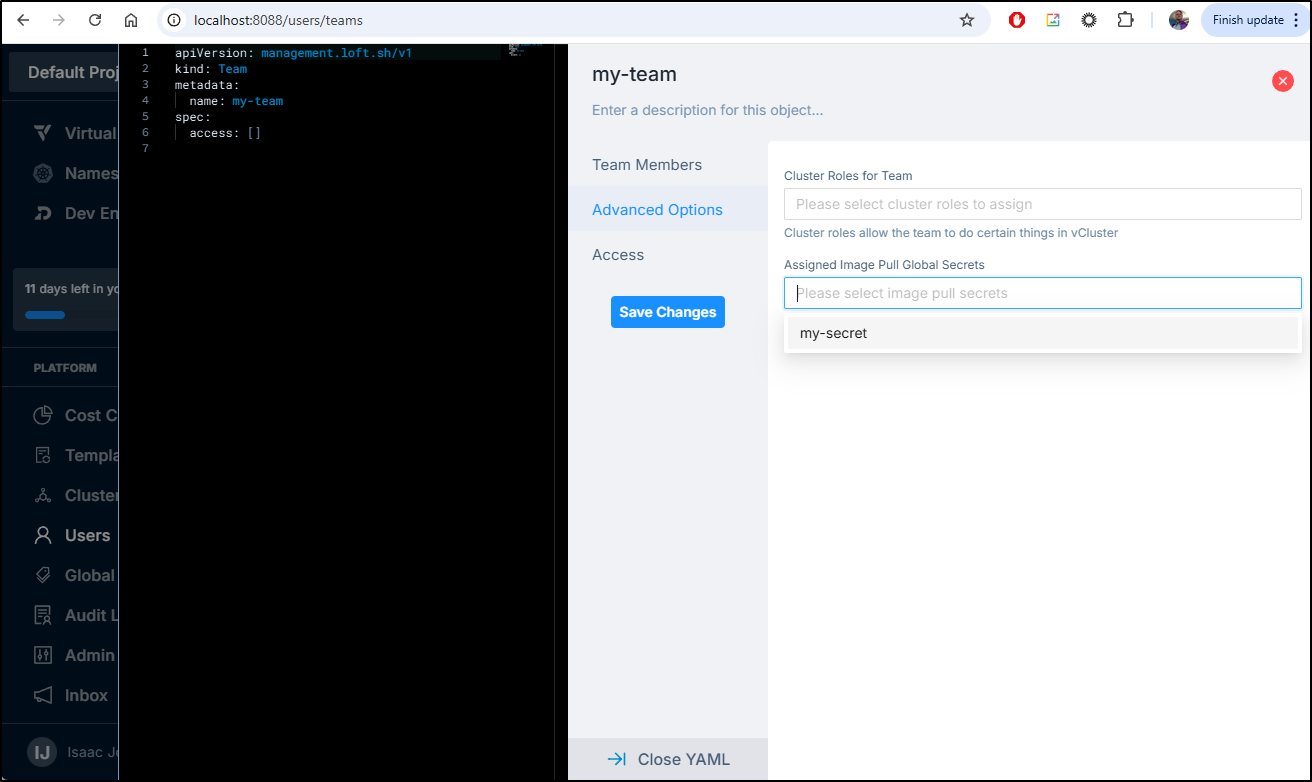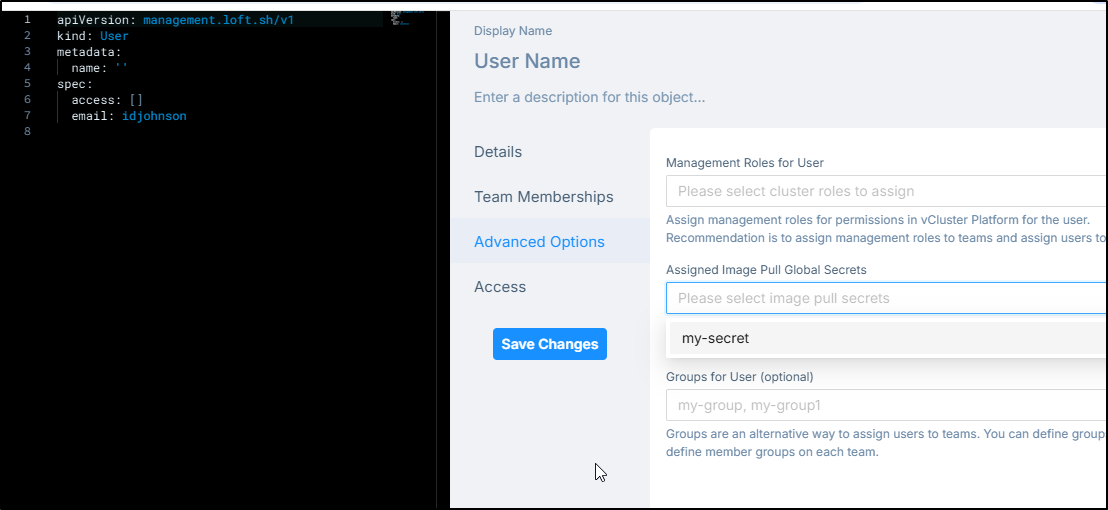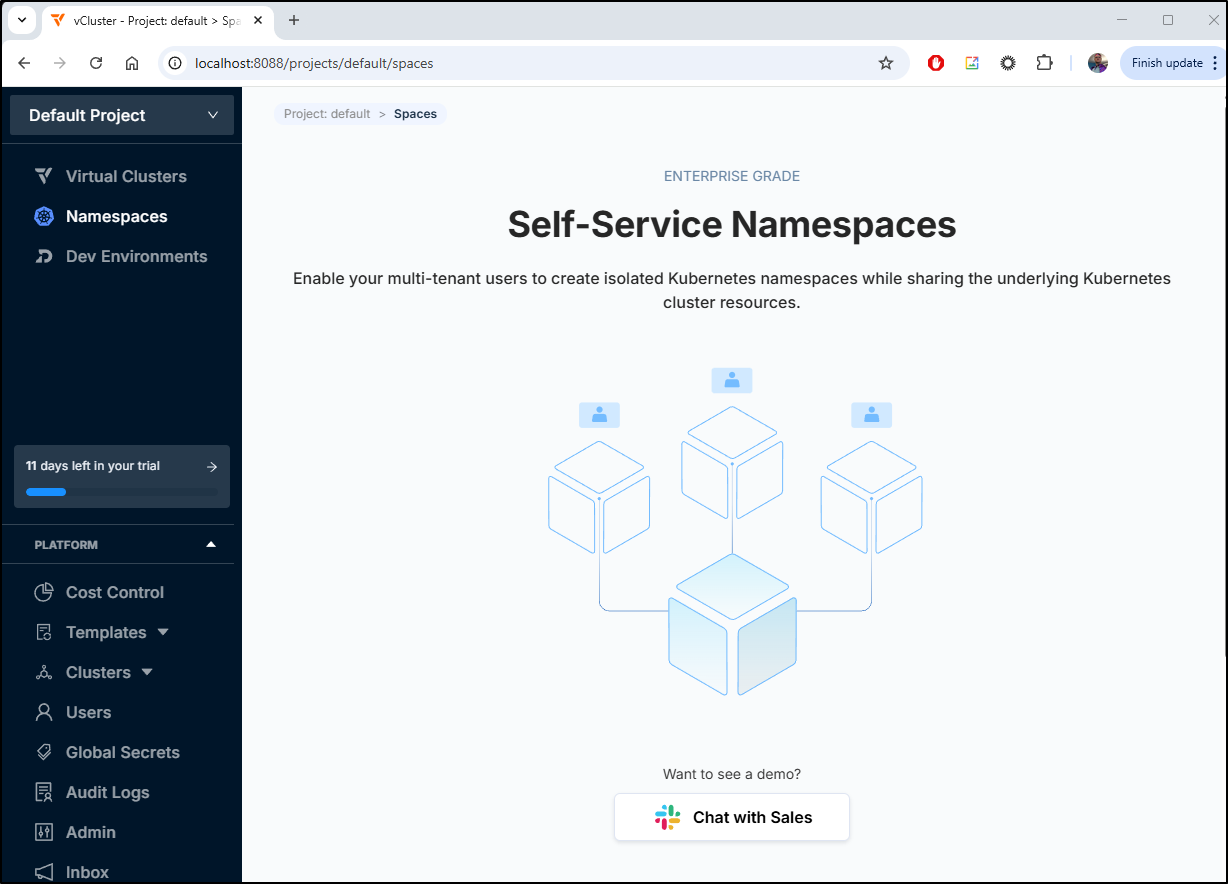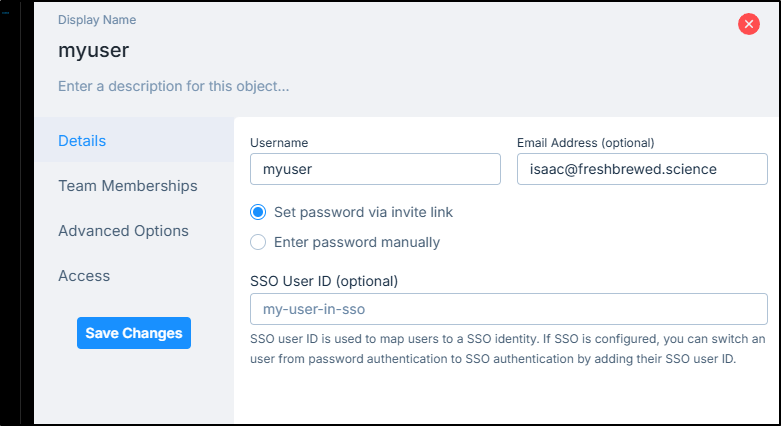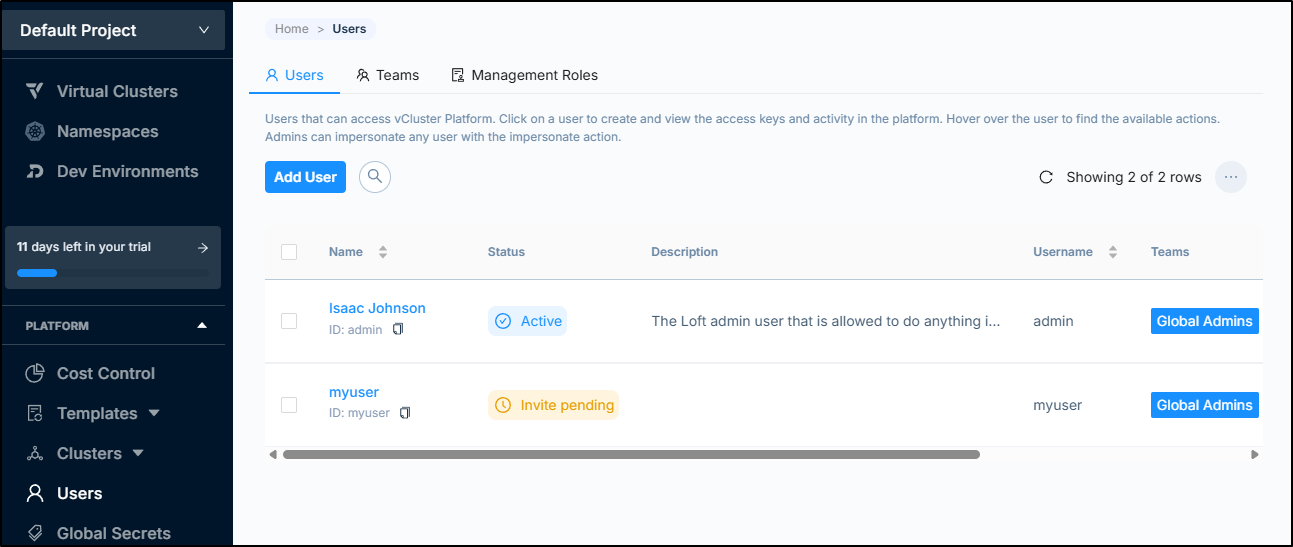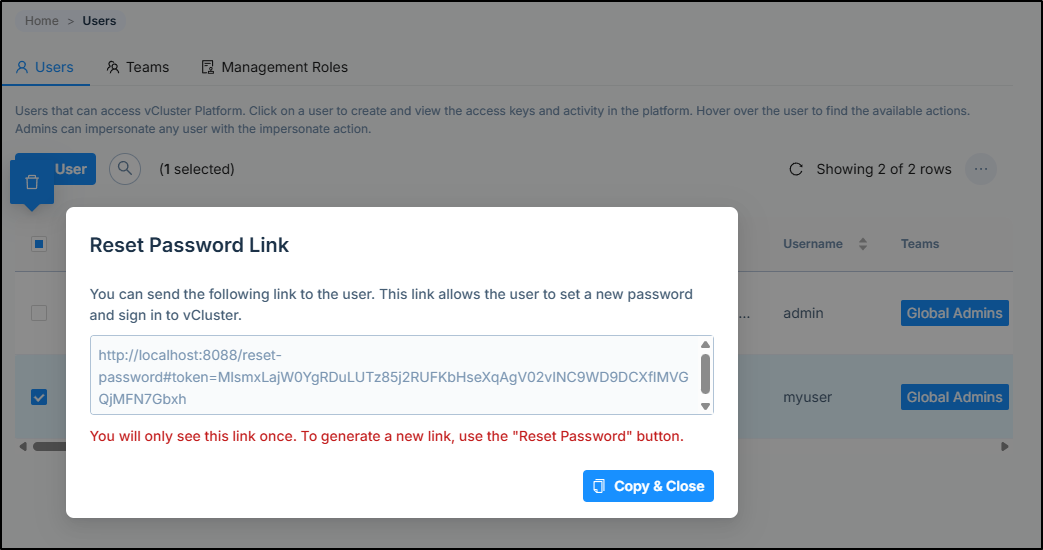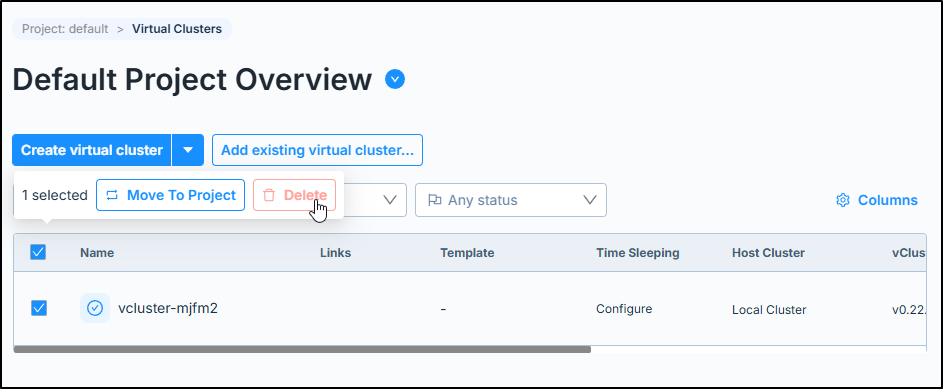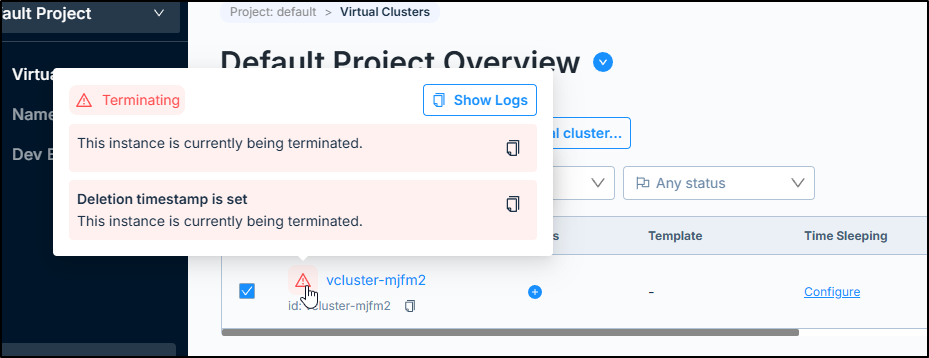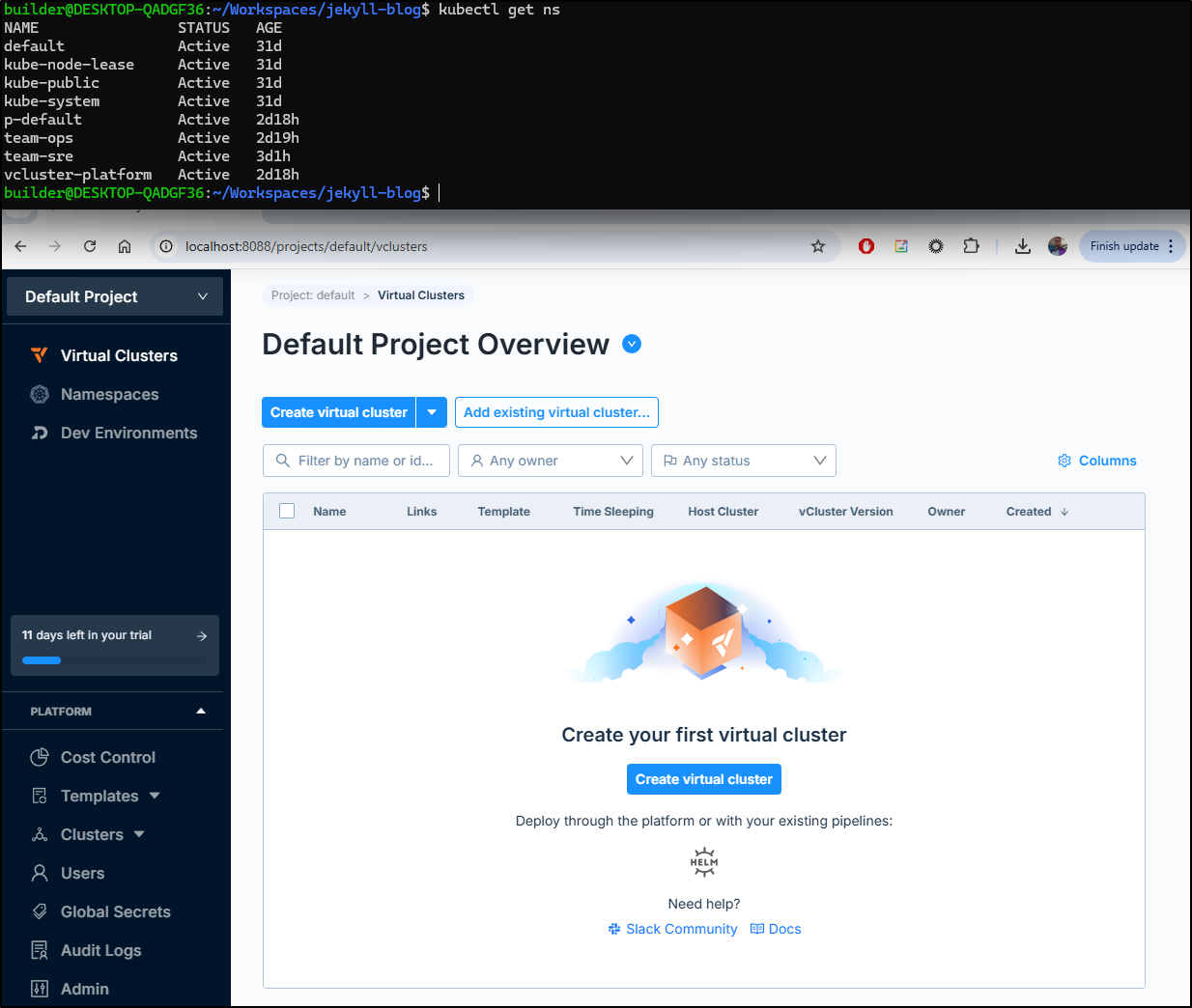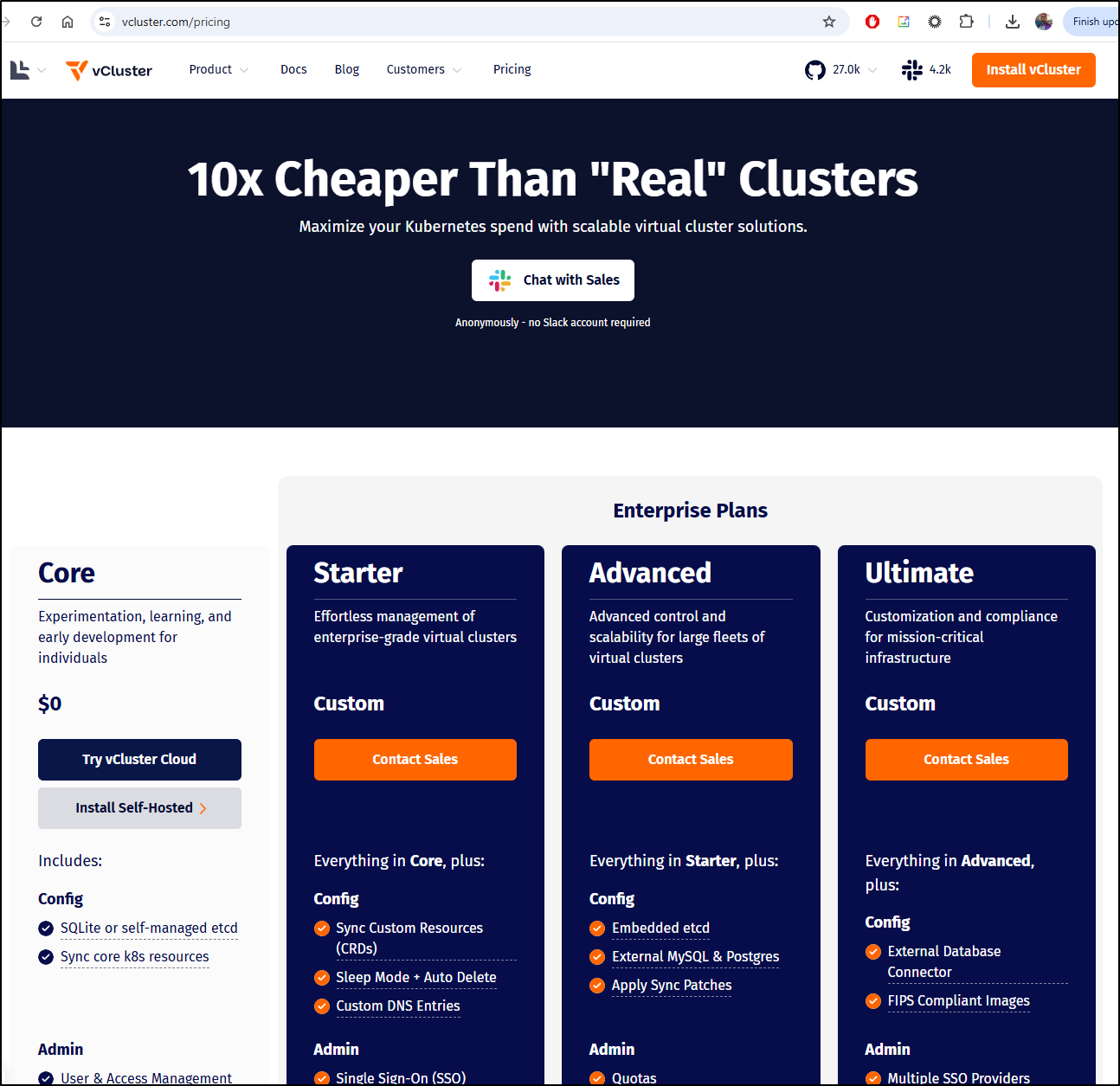Published: May 6, 2025 by Isaac Johnson
When I recently looked at DevPod I noticed it was from Loft.sh, which I had covered a few years ago. It seems that over time they’ve lined up their products around more exacting channels (moving vClusters to vcluster.com).
As their offerings are open-source, I wanted to dig back in and see what is new with vClusters, how well do they work, and have they made any big improvements.
Today we’ll set up vClusters by both the CLI and the platform UI. We’ll look at connectivity via Windows and Linux and some of the features in the vCluster platform.
Company
Three years ago, when I last took a look at vClusters by Loft.sh, I noted that they were in seed funding and at around 11-50 employees. It seems that has not changed.
However, according to Crunchbase, they are very likely positioned to get acquired at this stage
That said, the Founders, Lukas Gentele and Fabian Kramm are still three and in the same roles (CEO and CTO, respectively).
vCluster
We can head over to vcluster.com to get started. The install steps have far more options now, including homebrew, helm, Terraform/OpenTofu and ArgoCD
Homebrew
I’ll start with homebrew since I always prefer to brew install things when that option is available.
I first need to brew install loft-sh/tap/vcluster
$ brew install loft-sh/tap/vcluster
==> Auto-updating Homebrew...
Adjust how often this is run with HOMEBREW_AUTO_UPDATE_SECS or disable with
HOMEBREW_NO_AUTO_UPDATE. Hide these hints with HOMEBREW_NO_ENV_HINTS (see `man brew`).
Warning: loft-sh/tap/vcluster 0.23.2 is already installed and up-to-date.
To reinstall 0.23.2, run:
brew reinstall vcluster
$ vcluster --version
vcluster version 0.23.2
I can now create a virtual cluster for “team-sre”
$ vcluster create sre-vcluster --namespace team-sre
07:20:56 warn There is a newer version of vcluster: v0.24.1. Run `vcluster upgrade` to upgrade to the newest version.
07:20:57 info Creating namespace team-sre
07:20:58 info Create vcluster sre-vcluster...
07:20:58 info execute command: helm upgrade sre-vcluster /tmp/vcluster-0.23.2.tgz-389014886 --create-namespace --kubeconfig /tmp/3761679172 --namespace team-sre --install --repository-config='' --values /tmp/1342473163
07:21:06 done Successfully created virtual cluster sre-vcluster in namespace team-sre
07:21:33 info Waiting for vcluster to come up...
07:21:33 info vcluster is waiting, because vcluster pod sre-vcluster-0 has status: Init:0/3
07:21:43 info vcluster is waiting, because vcluster pod sre-vcluster-0 has status: Init:0/3
07:21:54 info vcluster is waiting, because vcluster pod sre-vcluster-0 has status: Init:0/3
07:22:05 info vcluster is waiting, because vcluster pod sre-vcluster-0 has status: Init:0/3
07:22:16 info vcluster is waiting, because vcluster pod sre-vcluster-0 has status: Init:1/3
07:22:27 info vcluster is waiting, because vcluster pod sre-vcluster-0 has status: Init:1/3
07:22:37 info vcluster is waiting, because vcluster pod sre-vcluster-0 has status: Init:1/3
07:22:48 info vcluster is waiting, because vcluster pod sre-vcluster-0 has status: Init:2/3
07:22:59 info vcluster is waiting, because vcluster pod sre-vcluster-0 has status: Init:2/3
07:23:53 done vCluster is up and running
07:23:53 info Starting background proxy container...
07:24:07 done Switched active kube context to vcluster_sre-vcluster_team-sre_mac77
- Use `vcluster disconnect` to return to your previous kube context
- Use `kubectl get namespaces` to access the vcluster
When I use kubectx, I can now see a new context has been added and set to default
$ kubectx
docker-desktop
ext33
ext77
ext81
int33
mac77
mac81
vcluster_sre-vcluster_team-sre_mac77
However, I found this didn’t actually work as it assumed a cluster was hosted locally on 127.0.0.1
(note: later I realized you have to “connect” and see that is connected. In my case WSL just was not connecting)
$ kubectl get nodes
E0502 07:25:24.014484 69926 memcache.go:265] "Unhandled Error" err="couldn't get current server API group list: Get \"https://127.0.0.1:11491/api?timeout=32s\": dial tcp 127.0.0.1:11491: connect: connection refused"
E0502 07:25:24.016236 69926 memcache.go:265] "Unhandled Error" err="couldn't get current server API group list: Get \"https://127.0.0.1:11491/api?timeout=32s\": dial tcp 127.0.0.1:11491: connect: connection refused"
E0502 07:25:24.017679 69926 memcache.go:265] "Unhandled Error" err="couldn't get current server API group list: Get \"https://127.0.0.1:11491/api?timeout=32s\": dial tcp 127.0.0.1:11491: connect: connection refused"
E0502 07:25:24.019073 69926 memcache.go:265] "Unhandled Error" err="couldn't get current server API group list: Get \"https://127.0.0.1:11491/api?timeout=32s\": dial tcp 127.0.0.1:11491: connect: connection refused"
E0502 07:25:24.020414 69926 memcache.go:265] "Unhandled Error" err="couldn't get current server API group list: Get \"https://127.0.0.1:11491/api?timeout=32s\": dial tcp 127.0.0.1:11491: connect: connection refused"
The connection to the server 127.0.0.1:11491 was refused - did you specify the right host or port?
$ kubectl get namespaces
E0502 07:26:02.358694 69965 memcache.go:265] "Unhandled Error" err="couldn't get current server API group list: Get \"https://127.0.0.1:11491/api?timeout=32s\": dial tcp 127.0.0.1:11491: connect: connection refused"
E0502 07:26:02.360356 69965 memcache.go:265] "Unhandled Error" err="couldn't get current server API group list: Get \"https://127.0.0.1:11491/api?timeout=32s\": dial tcp 127.0.0.1:11491: connect: connection refused"
E0502 07:26:02.361863 69965 memcache.go:265] "Unhandled Error" err="couldn't get current server API group list: Get \"https://127.0.0.1:11491/api?timeout=32s\": dial tcp 127.0.0.1:11491: connect: connection refused"
E0502 07:26:02.363553 69965 memcache.go:265] "Unhandled Error" err="couldn't get current server API group list: Get \"https://127.0.0.1:11491/api?timeout=32s\": dial tcp 127.0.0.1:11491: connect: connection refused"
E0502 07:26:02.365006 69965 memcache.go:265] "Unhandled Error" err="couldn't get current server API group list: Get \"https://127.0.0.1:11491/api?timeout=32s\": dial tcp 127.0.0.1:11491: connect: connection refused"
The connection to the server 127.0.0.1:11491 was refused - did you specify the right host or port?
From the kubeconfig:
server: https://127.0.0.1:11491
name: vcluster_sre-vcluster_team-sre_mac77
If I head back to the mac77 cluster, I can see the “sre-vcluster” was created with servics
$ kubectx mac77
Switched to context "mac77".
$ kubectl get svc -A
NAMESPACE NAME TYPE CLUSTER-IP EXTERNAL-IP PORT(S) AGE
default kubernetes ClusterIP 10.43.0.1 <none> 443/TCP 28d
kube-system kube-dns ClusterIP 10.43.0.10 <none> 53/UDP,53/TCP,9153/TCP 28d
kube-system metrics-server ClusterIP 10.43.51.82 <none> 443/TCP 28d
team-sre kube-dns-x-kube-system-x-sre-vcluster ClusterIP 10.43.166.221 <none> 53/UDP,53/TCP,9153/TCP 3m50s
team-sre sre-vcluster ClusterIP 10.43.130.46 <none> 443/TCP,10250/TCP 6m34s
team-sre sre-vcluster-headless ClusterIP None <none> 443/TCP 6m34s
team-sre sre-vcluster-node-isaac-macbookpro ClusterIP 10.43.211.16 <none> 10250/TCP 3m48s
I tried using that server and port just to see:
server: https://192.168.1.78:10250
name: vcluster_sre-vcluster_team-sre_mac77
But that failed to work
$ kubectl --insecure-skip-tls-verify get nodes
E0502 07:30:19.938304 70214 memcache.go:265] "Unhandled Error" err="couldn't get current server API group list: the server could not find the requested resource"
E0502 07:30:19.939745 70214 memcache.go:265] "Unhandled Error" err="couldn't get current server API group list: the server could not find the requested resource"
E0502 07:30:19.941189 70214 memcache.go:265] "Unhandled Error" err="couldn't get current server API group list: the server could not find the requested resource"
E0502 07:30:19.942530 70214 memcache.go:265] "Unhandled Error" err="couldn't get current server API group list: the server could not find the requested resource"
E0502 07:30:19.943855 70214 memcache.go:265] "Unhandled Error" err="couldn't get current server API group list: the server could not find the requested resource"
Error from server (NotFound): the server could not find the requested resource
I can switch back to my mac77 cluster and see it was created
$ kubectx mac77
Switched to context "mac77".
$ vcluster list
NAME | NAMESPACE | STATUS | VERSION | CONNECTED | AGE
---------------+-----------+---------+---------+-----------+---------
sre-vcluster | team-sre | Running | 0.23.2 | | 10m57s
But trying to connect seems to fail each time
$ vcluster connect --local-port 11491 sre-vcluster
07:32:35 warn There is a newer version of vcluster: v0.24.1. Run `vcluster upgrade` to upgrade to the newest version.
07:32:37 done vCluster is up and running
07:32:37 info Stopping background proxy...
07:32:37 info Starting background proxy container...
07:32:37 done Switched active kube context to vcluster_sre-vcluster_team-sre_mac77
- Use `vcluster disconnect` to return to your previous kube context
- Use `kubectl get namespaces` to access the vcluster
$ kubectl get nodes
E0502 07:32:44.041902 70383 memcache.go:265] "Unhandled Error" err="couldn't get current server API group list: Get \"https://127.0.0.1:11491/api?timeout=32s\": dial tcp 127.0.0.1:11491: connect: connection refused"
E0502 07:32:44.043404 70383 memcache.go:265] "Unhandled Error" err="couldn't get current server API group list: Get \"https://127.0.0.1:11491/api?timeout=32s\": dial tcp 127.0.0.1:11491: connect: connection refused"
E0502 07:32:44.044838 70383 memcache.go:265] "Unhandled Error" err="couldn't get current server API group list: Get \"https://127.0.0.1:11491/api?timeout=32s\": dial tcp 127.0.0.1:11491: connect: connection refused"
E0502 07:32:44.046221 70383 memcache.go:265] "Unhandled Error" err="couldn't get current server API group list: Get \"https://127.0.0.1:11491/api?timeout=32s\": dial tcp 127.0.0.1:11491: connect: connection refused"
E0502 07:32:44.047561 70383 memcache.go:265] "Unhandled Error" err="couldn't get current server API group list: Get \"https://127.0.0.1:11491/api?timeout=32s\": dial tcp 127.0.0.1:11491: connect: connection refused"
The connection to the server 127.0.0.1:11491 was refused - did you specify the right host or port?
Note: as I said before, moving to my primary windows host worked with the same steps, so I think this has something to do with my WSL
Helm
Let’s try the helm approach
I’ll reset back to the test cluster
$ kubectx mac77
Switched to context "mac77".
$ kubectl get nodes
NAME STATUS ROLES AGE VERSION
builder-macbookpro2 Ready <none> 28d v1.31.4+k3s1
isaac-macbookair Ready control-plane,master 28d v1.31.4+k3s1
isaac-macbookpro Ready <none> 28d v1.31.4+k3s1
Now let’s use Helm to install another team
$ helm upgrade --install my-vcluster vcluster \
rts.loft.sh \
--namespace team-o> --repo https://charts.loft.sh \
> --namespace team-ops \
> --repository-config='' \
> --create-namespace
Release "my-vcluster" does not exist. Installing it now.
NAME: my-vcluster
LAST DEPLOYED: Fri May 2 13:36:45 2025
NAMESPACE: team-ops
STATUS: deployed
REVISION: 1
TEST SUITE: None
I can now see it listed
$ vcluster list
NAME | NAMESPACE | STATUS | VERSION | CONNECTED | AGE
---------------+-----------+----------+---------+-----------+----------
my-vcluster | team-ops | Init:0/3 | 0.24.1 | | 18s
sre-vcluster | team-sre | Running | 0.23.2 | | 6h16m2s
Windows
I’ll try and download a release from Github Releases.
(Note: I did try to follow their steps for using Powershell at first, but the IWR just was not finding the right release so I decided to KISS and just download from Github directly)
I can now try using it to list vClusters
PS C:\Users\isaac> kubectl get nodes
NAME STATUS ROLES AGE VERSION
builder-macbookpro2 Ready <none> 28d v1.31.4+k3s1
isaac-macbookair Ready control-plane,master 28d v1.31.4+k3s1
isaac-macbookpro Ready <none> 28d v1.31.4+k3s1
PS C:\Users\isaac> C:\Users\isaac\Downloads\vcluster-windows-amd64.exe list
NAME | NAMESPACE | STATUS | VERSION | CONNECTED | AGE
---------------+-----------+---------+---------+-----------+----------
my-vcluster | team-ops | Running | 0.24.1 | | 13m16s
sre-vcluster | team-sre | Running | 0.23.2 | | 6h29m0s
This worked to connect a local vCluster
PS C:\Users\isaac> C:\Users\isaac\Downloads\vcluster-windows-amd64.exe connect sre-vcluster
13:51:27 warn There is a newer version of vcluster: v0.24.1. Run `vcluster upgrade` to upgrade to the newest version.
13:51:28 done vCluster is up and running
13:51:29 info Stopping background proxy...
13:51:29 info Starting background proxy container...
13:51:30 done Switched active kube context to vcluster_sre-vcluster_team-sre_mac77
- Use `vcluster disconnect` to return to your previous kube context
- Use `kubectl get namespaces` to access the vcluster
PS C:\Users\isaac> kubectl get namespaces
NAME STATUS AGE
default Active 6h28m
kube-node-lease Active 6h28m
kube-public Active 6h28m
kube-system Active 6h28m
I confirmed it does show as 127.0.0.1 in the config
server: https://127.0.0.1:11189
name: vcluster_sre-vcluster_team-sre_mac77
This time, however, we can clearly see we are connected
PS C:\Users\isaac\.kube> C:\Users\isaac\Downloads\vcluster-windows-amd64.exe list
NAME | NAMESPACE | STATUS | VERSION | CONNECTED | AGE
---------------+-----------+---------+---------+-----------+-----------
my-vcluster | team-ops | Running | 0.24.1 | | 16m11s
sre-vcluster | team-sre | Running | 0.23.2 | True | 6h31m55s
13:53:02 info Run `vcluster disconnect` to switch back to the parent context
We can see that if we make a namespace, it shows up in the vCluster
PS C:\Users\isaac\.kube> kubectl create ns fakens
namespace/fakens created
PS C:\Users\isaac\.kube> kubectl get nodes
NAME STATUS ROLES AGE VERSION
isaac-macbookpro Ready <none> 6h32m v1.31.4
PS C:\Users\isaac\.kube> kubectl get ns
NAME STATUS AGE
default Active 6h32m
fakens Active 2m20s
kube-node-lease Active 6h32m
kube-public Active 6h32m
kube-system Active 6h32m
But it only exists in the vCluster so if we head back to the hosting cluster, we only see our vCluster namespaces, but also see all the nodes
PS C:\Users\isaac\.kube> kubectl get ns
NAME STATUS AGE
default Active 28d
kube-node-lease Active 28d
kube-public Active 28d
kube-system Active 28d
team-ops Active 18m
team-sre Active 6h34m
PS C:\Users\isaac\.kube> kubectl get nodes
NAME STATUS ROLES AGE VERSION
builder-macbookpro2 Ready <none> 28d v1.31.4+k3s1
isaac-macbookair Ready control-plane,master 28d v1.31.4+k3s1
isaac-macbookpro Ready <none> 28d v1.31.4+k3s1
Platform
Let’s add the vCluster Platform via Helm
$ helm upgrade vcluster-platform vcluster-platform --install \
--repo https://charts.loft.sh/ \
--namespace vcluster-platform \
--create-namespace
I can then see the services created
$ kubectl get svc -n vcluster-platform
NAME TYPE CLUSTER-IP EXTERNAL-IP PORT(S) AGE
loft ClusterIP 10.43.142.75 <none> 80/TCP,443/TCP 46s
loft-apiservice ClusterIP 10.43.199.69 <none> 443/TCP 46s
loft-apiservice-agent ClusterIP 10.43.154.222 <none> 443/TCP 46s
loft-ingress-wakeup-agent ClusterIP 10.43.204.162 <none> 9090/TCP 46s
loft-webhook-agent ClusterIP 10.43.26.102 <none> 443/TCP 46s
I can fire off a kubectl port-forward to the main vCluster service
PS C:\Users\isaac\Workspaces> kubectl port-forward svc/loft 8088:80 -n vcluster-platform
Forwarding from 127.0.0.1:8088 -> 8080
Forwarding from [::1]:8088 -> 8080
Handling connection for 8088
Handling connection for 8088
Handling connection for 8088
Handling connection for 8088
Handling connection for 8088
Handling connection for 8088
We can fetch our user/password from the helm chart
$ helm get values --all vcluster-platform -n vcluster-platform
COMPUTED VALUES:
additionalCA: ""
admin:
create: true
password: my-password
username: admin
I can now see my clusters, which for this platform shows none
I was a bit worked about the note “13 days left in your trial”, only to see it opts in to “vCluster Enterprise Trial” by default
I’ll create a new cluster with Platform
I’ll now use default settings for my vCluster
This starts the create process
soon it was created
I want to point out that we can see this with the vCluster CLI as well!
However, in the UI, we can not only see the vcluster command but also download a kube config
Trying that did not work
PS C:\Users\isaac> kubectl get nodes --kubeconfig C:\Users\isaac\Downloads\kubeconfig.yaml
Unable to connect to the server: http: server gave HTTP response to HTTPS client
However, using the binary to connect did
PS C:\Users\isaac> C:\Users\isaac\Downloads\vcluster-windows-amd64.exe list
NAME | NAMESPACE | STATUS | VERSION | CONNECTED | AGE
-----------------+-------------------------------+---------+---------+-----------+-----------
vcluster-mjfm2 | loft-default-v-vcluster-mjfm2 | Running | 0.22.5 | | 16m43s
my-vcluster | team-ops | Running | 0.24.1 | | 58m57s
sre-vcluster | team-sre | Running | 0.23.2 | | 7h14m41s
PS C:\Users\isaac> C:\Users\isaac\Downloads\vcluster-windows-amd64.exe connect vcluster-mjfm2
14:35:56 warn There is a newer version of vcluster: v0.24.1. Run `vcluster upgrade` to upgrade to the newest version.
14:35:58 done vCluster is up and running
14:35:58 info Starting background proxy container...
14:35:59 done Switched active kube context to vcluster_vcluster-mjfm2_loft-default-v-vcluster-mjfm2_mac77
- Use `vcluster disconnect` to return to your previous kube context
- Use `kubectl get namespaces` to access the vcluster
I can see I’m connected
PS C:\Users\isaac> C:\Users\isaac\Downloads\vcluster-windows-amd64.exe list
NAME | NAMESPACE | STATUS | VERSION | CONNECTED | AGE
-----------------+-------------------------------+---------+---------+-----------+-----------
vcluster-mjfm2 | loft-default-v-vcluster-mjfm2 | Running | 0.22.5 | True | 17m52s
my-vcluster | team-ops | Running | 0.24.1 | | 1h0m6s
sre-vcluster | team-sre | Running | 0.23.2 | | 7h15m50s
14:36:57 info Run `vcluster disconnect` to switch back to the parent context
and view things like namespaces
PS C:\Users\isaac> kubectl get nodes
No resources found
PS C:\Users\isaac> kubectl get ns
NAME STATUS AGE
default Active 16m
kube-node-lease Active 16m
kube-public Active 16m
kube-system Active 16m
DevPod Integration?
I saw a “Dev Environments” section that got me excited that we could fire off DevPods in here, but it seems more like just a static page to suggest we use DevPod
I really thought I would see, at the least, a “DevPod” app install that we could fire off from Apps, but no such luck
Apps
We can fire apps into our vCluster using the platform UI if desired.
For instance, if we wished to do GitOps via ArgoCD, we could use the Argo CD chart.
Clicking install pops up a window where we can see it install
Once done, I can see it is listed in the “Apps” section of my vCluster
and as you can see, since I’m connected to my vCluster, I can port-forward to the service to access ArgoCD
I can also reach my services from the hosting cluster as the services are exposed in the vCluster namespace.
For instance, I can port-forward to that same ArgoCD by way of the primary mac77 kube context:
Sleep
One of the features that is new to me is “sleep” that lets us just put the whole cluster to bed and scale it to zero when not in use:
We can now see the vCluster is taking a nap:
And more importantly, we can see the pods went from:
$ kubectl get po -n loft-default-v-vcluster-mjfm2
NAME READY STATUS RESTARTS AGE
argocd-application-controller-0-x-argocd-x-vcluster-mjfm2 1/1 Running 0 11m
argocd-applicationset-controller-b9f789649-5hsfj-x-a-b03ec82d91 1/1 Running 0 11m
argocd-dex-server-58b585f5b9-t9x5g-x-argocd-x-vcluster-mjfm2 1/1 Running 0 11m
argocd-notifications-controller-f66d57bcf-fldwd-x-ar-2214f8b04e 1/1 Running 0 11m
argocd-redis-9b66c678-cbhnl-x-argocd-x-vcluster-mjfm2 1/1 Running 0 11m
argocd-repo-server-79fbf7c5c8-8pnmn-x-argocd-x-vcluster-mjfm2 1/1 Running 0 11m
argocd-server-79b96f9f4f-ldv6l-x-argocd-x-vcluster-mjfm2 1/1 Running 0 11m
vcluster-mjfm2-0 1/1 Running 0 36m
to
$ kubectl get po -n loft-default-v-vcluster-mjfm2
No resources found in loft-default-v-vcluster-mjfm2 namespace.
This is a great way to turn on-and-off vCluster for test projects/temporary environments.
We can use the Platform manager to “Wake up”
In the vcluster CLI, the state will show “Unknown”.
Since I’m not authenticated as a Platform Admin, I cannot just “resume” a “sleeping” cluster this way, not without logging in
$ vcluster list
NAME | NAMESPACE | STATUS | VERSION | CONNECTED | AGE
-----------------+-------------------------------+---------+---------+-----------+-----------
vcluster-mjfm2 | loft-default-v-vcluster-mjfm2 | Unknown | 0.22.5 | | 41m21s
my-vcluster | team-ops | Running | 0.24.1 | | 1h23m35s
sre-vcluster | team-sre | Running | 0.23.2 | | 7h39m19s
$ vcluster resume vcluster-mjfm2
15:00:34 fatal create management client: not logged in, please make sure you have run 'vcluster platform start' to create one or 'vcluster login [vcluster-pro-url]' if one already exists
I noticed that the “Age” is from create, not resumed, nor discounting any “sleep” time
Cost control
We can view costs via “Cost Control”
I gave it a couple days to view data and it suggested I saved $2 by using a vCluster
To really use Cost Savings accurately, however, one needs to go the gear icon by “Cost Settings” and set your usual spend because Kubernetes costs can vary wildly by implementation
Glboal Secrets
To help solve secrets management, vClusters offers a “Global Secrets” option that can let us sync a managed secret though the CLI or a K8s secret.
We can go to “Global Secrets” to “Add Global Secret”
As I type the value, I can see on the left it’s BASE64 encoding it
I was somewhat amused by the fact that when you move off of edit mode in the UI, it does a gaussian blur effect on the value (that isn’t me), but then leaves the base64 just as it is so I guess it masks it from people that don’t know how to b64 decode?
I can also set some permissions here which are reflected in the spec.access area:
I saved it but when I went to check my vCluster, I did not see it propagated there
PS C:\Users\isaac\.kube> C:\Users\isaac\Downloads\vcluster-windows-amd64.exe disconnect
08:08:29 info Successfully disconnected and switched back to the original context: mac77
PS C:\Users\isaac\.kube> C:\Users\isaac\Downloads\vcluster-windows-amd64.exe connect vcluster-mjfm2
08:08:36 warn There is a newer version of vcluster: v0.24.1. Run `vcluster upgrade` to upgrade to the newest version.
08:08:38 done vCluster is up and running
08:08:38 info Starting background proxy container...
08:08:39 done Switched active kube context to vcluster_vcluster-mjfm2_loft-default-v-vcluster-mjfm2_mac77
- Use `vcluster disconnect` to return to your previous kube context
- Use `kubectl get namespaces` to access the vcluster
PS C:\Users\isaac\.kube> kubectl get ns
NAME STATUS AGE
argocd Active 2d17h
default Active 2d17h
kube-node-lease Active 2d17h
kube-public Active 2d17h
kube-system Active 2d17h
PS C:\Users\isaac\.kube> kubectl get secret -A
NAMESPACE NAME TYPE DATA AGE
argocd argocd-initial-admin-secret Opaque 1 2d17h
argocd argocd-notifications-secret Opaque 0 2d17h
argocd argocd-redis Opaque 1 2d17h
argocd argocd-secret Opaque 5 2d17h
argocd sh.helm.release.v1.argocd.v1 helm.sh/release.v1 1 2d17h
Nor via the UI in vCluster
I also went to the hosting cluster to check if its in the ‘vcluster-platform’ namespace
builder@DESKTOP-QADGF36:~/Workspaces/jekyll-blog$ kubectl get secrets -n vcluster-platform
NAME TYPE DATA AGE
loft-agent-connection Opaque 2 2d18h
loft-api-service-cert kubernetes.io/tls 3 2d18h
loft-apiservice-agent-cert kubernetes.io/tls 3 2d18h
loft-cert kubernetes.io/tls 3 2d18h
loft-ingress-wakeup-agent-server-cert kubernetes.io/tls 3 2d18h
loft-manager-config Opaque 1 2d18h
loft-network-control-key Opaque 3 2d18h
loft-router-domain Opaque 1 2d18h
loft-server-cert kubernetes.io/tls 3 2d18h
loft-user-secret-admin Opaque 1 2d18h
loft-webhook-agent-cert kubernetes.io/tls 3 2d18h
sh.helm.release.v1.global-prometheus.v1 helm.sh/release.v1 1 2d18h
sh.helm.release.v1.global-prometheus.v2 helm.sh/release.v1 1 2d18h
sh.helm.release.v1.opencost.v1 helm.sh/release.v1 1 2d18h
sh.helm.release.v1.prometheus.v1 helm.sh/release.v1 1 2d18h
sh.helm.release.v1.vcluster-platform.v1 helm.sh/release.v1 1 2d18h
builder@DESKTOP-QADGF36:~/Workspaces/jekyll-blog$ kubectl get secrets -n vcluster-platform -o yaml | grep -i my-secret
However, that was when I realized they make their own Custom Resource (SharedSecret):
$ kubectl get SharedSecret -A
NAMESPACE NAME CREATED AT
vcluster-platform my-secret 2025-05-05T13:06:01Z
$ kubectl get SharedSecret my-secret -n vcluster-platform -o json | jq -r .spec.data.mysecret | base64 --decode && echo
somespecialvalue
Though that type does not exist in the vCluster
PS C:\Users\isaac\.kube> kubectl get sharedsecret -A
error: the server doesn't have a resource type "sharedsecret"
Nor is there a sync option (just delete) from the “Shared Secret” menu
I decided I would try one more thing - the old “turn it off and on again”
I disconnected from the vCluster in windows
PS C:\Users\isaac\.kube> C:\Users\isaac\Downloads\vcluster-windows-amd64.exe disconnect
08:16:58 info Successfully disconnected and switched back to the original context: mac77
Then put it to sleep
then wake up
I reconnected, but still no go
PS C:\Users\isaac\.kube> C:\Users\isaac\Downloads\vcluster-windows-amd64.exe connect vcluster-mjfm2
08:22:19 warn There is a newer version of vcluster: v0.24.1. Run `vcluster upgrade` to upgrade to the newest version.
08:22:21 done vCluster is up and running
08:22:21 info Stopping background proxy...
08:22:22 info Starting background proxy container...
08:22:23 done Switched active kube context to vcluster_vcluster-mjfm2_loft-default-v-vcluster-mjfm2_mac77
- Use `vcluster disconnect` to return to your previous kube context
- Use `kubectl get namespaces` to access the vcluster
PS C:\Users\isaac\.kube> kubectl get sharedsecret -A
error: the server doesn't have a resource type "sharedsecret"
PS C:\Users\isaac\.kube> kubectl get secret -A
NAMESPACE NAME TYPE DATA AGE
argocd argocd-initial-admin-secret Opaque 1 2d17h
argocd argocd-notifications-secret Opaque 0 2d17h
argocd argocd-redis Opaque 1 2d17h
argocd argocd-secret Opaque 5 2d17h
argocd sh.helm.release.v1.argocd.v1 helm.sh/release.v1 1 2d17h
I have to believe, then, that “Shared Secrets” must just be a local Platform UI feature for basic secret sharing in the platform but not created vClusters.
If it could sync to namespaces in vClusters, I could see myself using it. Otherwise, I’m not really sure what the point is. I would far prefer to just use a secret store like AKV or GSM which versions it’s secrets.
Other features/odd UI elements
So there is an Inbox, but nothing you can do there and no idea how it could be used
Perhaps it’s just a placehold for Loft.sh company announcements?
There is user and team management.
For instance, you can create a team and let it pull from a shared image pull secret (perhaps that is the usage for “Global Secrets”?)
There is also a “Namespaces” placeholder with little to no information shown
User Creation
I was curious what “set password via invite link” might entail, so I created a user
(I had to change to gmail), but then it went to “Invite Pending”.
I don’t recall setting up an SMTP server so I’m curious if something is going to get sent somehow.
I checked - there is no mail server settings in the helm chart
$ helm get values --all -n vcluster-platform vcluster-platform
COMPUTED VALUES:
additionalCA: ""
admin:
create: true
password: my-password
username: admin
affinity:
nodeAffinity:
preferredDuringSchedulingIgnoredDuringExecution:
- preference:
matchExpressions:
- key: eks.amazonaws.com/capacityType
operator: NotIn
values:
- SPOT
- key: kubernetes.azure.com/scalesetpriority
operator: NotIn
values:
- spot
- key: cloud.google.com/gke-provisioning
operator: NotIn
values:
- spot
weight: 1
agentOnly: false
agentValues: {}
apiservice:
create: true
audit:
enableSideCar: false
image: library/alpine:3.13.1
persistence:
enabled: false
size: 10Gi
securityContext:
allowPrivilegeEscalation: false
capabilities:
drop:
- ALL
privileged: false
runAsNonRoot: true
runAsUser: 1000
certIssuer:
create: false
email: ""
httpResolver:
enabled: true
ingressClass: nginx
name: lets-encrypt-http-issuer
resolvers: []
secretName: loft-letsencrypt-credentials
server: https://acme-v02.api.letsencrypt.org/directory
config:
audit:
enabled: true
env: {}
envValueFrom: {}
hostAliases: []
ingress:
enabled: false
host: loft.mydomain.tld
ingressClass: nginx
name: loft-ingress
path: /
tls:
enabled: true
secret: loft-tls
insecureSkipVerify: false
livenessProbe:
enabled: true
logging:
encoding: console
level: info
persistence:
enabled: false
size: 30Gi
podDisruptionBudget:
create: true
minAvailable: 1
podSecurityContext: {}
product: vcluster-pro
readinessProbe:
enabled: true
replicaCount: 1
resources:
limits:
cpu: "2"
memory: 4Gi
requests:
cpu: 200m
memory: 256Mi
securityContext:
allowPrivilegeEscalation: false
capabilities:
drop:
- ALL
enabled: true
privileged: false
runAsNonRoot: true
service:
type: ClusterIP
serviceAccount:
annotations: {}
clusterRole: cluster-admin
create: true
imagePullSecrets: []
name: loft
serviceMonitor:
enabled: false
interval: 60s
jobLabel: loft
labels: {}
path: /metrics
scrapeTimeout: 30s
targetPort: 8080
tls:
crtKey: tls.crt
enabled: false
keyKey: tls.key
secret: loft-tls
token: ""
url: ""
volumeMounts: []
volumes: []
webhook:
create: true
I can see it was created in the logs
$ kubectl logs loft-6d88556b5d-9pmvt -n vcluster-platform | grep -i myuser
2025-05-05 13:31:07 INFO user-controller user/controller.go:90 Updated user access because it was out of sync {"component": "loft", "object": {"name":"myuser"}, "reconcileID": "8aca97df-0632-4994-92d1-21b9713ed985"}
2025-05-05 13:31:07 INFO clienthelper/clienthelper.go:347 created object {"component": "loft", "kind": "", "name": "loft-user-password-myuser-nr2sz"}
Nothing came through email (I gave it a few hours).
I can, however, reset the user’s password and vCluster Platform will provide a link I could send them
Cleanup
If we want to be done with vClusters, we can just delete our vCluster namespaces and the Loft Platform one.
PS C:\Users\isaac\Workspaces> kubectl get ns
NAME STATUS AGE
default Active 31d
kube-node-lease Active 31d
kube-public Active 31d
kube-system Active 31d
loft-default-v-vcluster-mjfm2 Active 2d18h
p-default Active 2d18h
team-ops Active 2d19h
team-sre Active 3d1h
vcluster-platform Active 2d18h
I’ll do it a bit more delicately and first disconnect any existing sessions
PS C:\Users\isaac\.kube> C:\Users\isaac\Downloads\vcluster-windows-amd64.exe disconnect
08:38:13 info Successfully disconnected and switched back to the original context: mac77
Then delete from the platform UI
I can see it’s now being terminated
Soon, in the hosting cluster, I saw the namespace show “Terminating”
$ kubectl get ns
NAME STATUS AGE
default Active 31d
kube-node-lease Active 31d
kube-public Active 31d
kube-system Active 31d
loft-default-v-vcluster-mjfm2 Terminating 2d18h
p-default Active 2d18h
team-ops Active 2d19h
team-sre Active 3d1h
vcluster-platform Active 2d18h
In a couple of minutes it was gone:
I could now delete the platform with helm delete global-prometheus -n vcluster-platform & helm delete opencost -n vcluster-platform & helm delete prometheus -n vcluster-platform & helm delete vcluster-platform -n vcluster-platform
However, since it’s just consuming some local-path disk, I’ll leave it be for now so I can see what happens in 11d when the “trial” license expires.
While those PVCs are provisioned for 60Gbi, they are barely using any space at the moment. Just to be certain, I hopped on the node and checked:
builder@isaac-MacBookPro:~$ sudo du -chs /var/lib/rancher/k3s/storage/pvc-04618221-09b3-4a5d-a1b3-7ed518991d46_vcluster-platform_storage-volume-prometheus-server
-0
23M /var/lib/rancher/k3s/storage/pvc-04618221-09b3-4a5d-a1b3-7ed518991d46_vcluster-platform_storage-volume-prometheus-server-0
23M total
Summary
Today we used a mix of helm and brew (and just downloading the windows binary) to setup vClusters. We found their is a nice “Platform” app that can help us manage and configure, however, the CLI works just as well.
We saw some features that are either not finished, or hidden behind a sales paywall (like namespaces) and what looks like future plans with a Devpod placeholder in the Platform UI.
When I revisit that post from 2022, I can see they moved from “Spaces” to “DevPod” and the UI is much nicer than before. I can also say the setup process was very clean.
I’ll be interested to see what happens when the default “Enterprise Trial” expires. I also tend to shy away from any solution whose prices are all “talk to us”
I would have expected at this point the product should have at least some straight-forward pricing at the Starter level.


